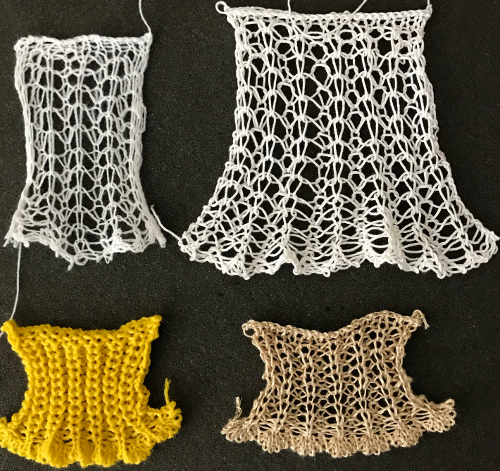Ribber trims 2 presented a series of ideas for edgings I meant to return to. Rather than adding more to that post presently, I am expanding on the topic here.
Scalloped trims are popular in single-bed knits. Preventing any needles from knitting for any number of rows will form a wave. If automatic needle selection is used, they may be formed using both the tuck and slip stitch settings.
This version from the Brother Ribber Techniques, with knitting directions included in Ribber trims and edgings 1  If there is a problem in double bed versions using loops formed by holding stitches or tuck patterning, try completing a tubular cast-on before starting either sequence.
If there is a problem in double bed versions using loops formed by holding stitches or tuck patterning, try completing a tubular cast-on before starting either sequence.
Using tuck stitch rows created manually way can work as a cast-on method:
Begin with a familiar yarn and tensions to form the usual zig-zag row from right to left
Set the ribber to slip in both directions
Bring every 6th needle on the top bed out to hold, and set the knit carriage to knit. 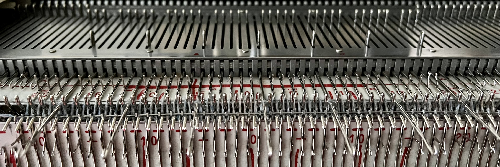 At that point the yarn will be knitting solely on the top bed, so tension needs to be adjusted closer to what may be normally used in knitting it in stocking stitch.
At that point the yarn will be knitting solely on the top bed, so tension needs to be adjusted closer to what may be normally used in knitting it in stocking stitch.
Set the ribber to slip in both directions.
Make at least 4 passes on the main bed, 6 will yield more of an effect but may be hard to manage on Japanese machines while in Passap, the strippers facilitate the process.
My first swatches were knit using 2/8 wool, which pushes the limits for smooth knitting in every needle rib on the 4.5mm machine. After knitting 5 rows the top bed stitches began riding up. 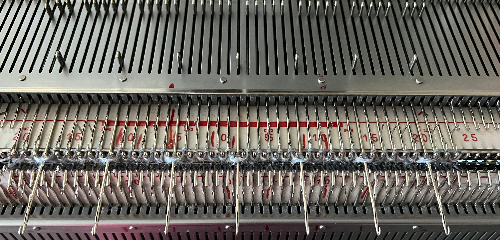 The next row needs to be knit across both beds, sealing the scallop.
The next row needs to be knit across both beds, sealing the scallop.
Bringing the top bed needles all the way forward can help with that, but to ensure gathered loops will knit off properly, a bit of fiddling may be required, any tool can be used to push down lightly on alternating sides of the loops to keep the stitches to their side from unraveling. 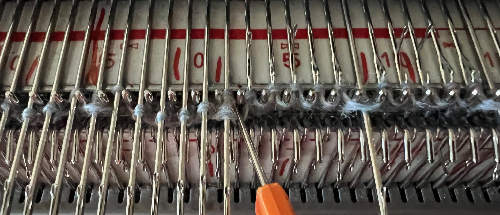 Release the hold lever on the top bed, set the ribber to knit in both directions, and continue in every needle rib to the desired length
Release the hold lever on the top bed, set the ribber to knit in both directions, and continue in every needle rib to the desired length
The top images show the result of forgetting to set the ribber to knit, so there are 2 extra all-knit rows on the top bed, the bottom images were knit with the proper setting transition 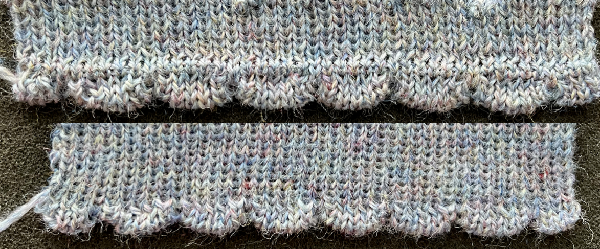 Since the top bed only knits for several rows, the ribber stitches can be seen elongated on this side of the knit
Since the top bed only knits for several rows, the ribber stitches can be seen elongated on this side of the knit  Switching to a 2/20 wool, the same needle spacing, and holding stitches for 6 rows:
Switching to a 2/20 wool, the same needle spacing, and holding stitches for 6 rows: 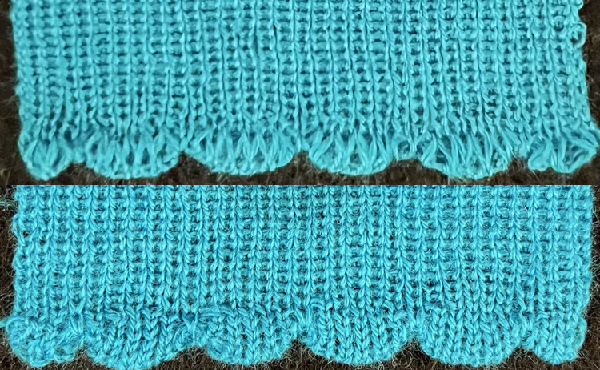 One last fiber switch, a different 2/20 wool shade.
One last fiber switch, a different 2/20 wool shade.
Here the detail is used at the bottom of the stocking stitch swatch rather than a ribbed one.
Watch for loops hung up on gatepegs, seen below in the top swatch.
The scallop shape wanted to turn toward the knit side but did set with some steaming.
Upon completing the holding sequence, transfer all ribber stitches to the top bed.
The tension in the swatch remained the same throughout, but in the bottom views, a loose joining row (perhaps too loose) was knit after transferring all ribber stitches to the top bed, as is often done for smoother transitions in single-bed hems. After the single loosely knit row, the tension is adjusted set to a number appropriate for the specific yarn in single-bed work.  This information and pngs expand on the knit charts in the 2019 post. If the pngs are copied, check that mode has not been altered to RGB automatically, and index back to BW mode prior to downloading them to machines for knitting.
This information and pngs expand on the knit charts in the 2019 post. If the pngs are copied, check that mode has not been altered to RGB automatically, and index back to BW mode prior to downloading them to machines for knitting.
Though, in general, starting side does not often matter, when testing techniques consistently beginning on the same side and leaving a yarn end will help identify which surface is knit facing or purl facing and whether that is of implications in the specific design.
Designing the repeat tiled for the width of the bed when working on electronic machines allows one the opportunity to add all knit borders in specific widths and to program the result as single motifs without concerns about needle placements on the knit bed or how to influence edges.
Punchcard knitters are faced with fixed 24-stitch locations on the needle bed, all knit borders would require manually bringing the needles involved out to E before each carriage pass.
As always, white pixels/unpunched areas tuck, and black pixels/ punched holes knit.
These repeats can make for interesting all-over fabrics as well as serve for edgings that flair and form bottoms that are wavy to different degrees.
12X18![]()
 Knit using a superfine 2/18 merino: the tension on either or both beds may need to be adjusted repeatedly for stitches to form and knit off properly, reflected in stitch size variations here.
Knit using a superfine 2/18 merino: the tension on either or both beds may need to be adjusted repeatedly for stitches to form and knit off properly, reflected in stitch size variations here. 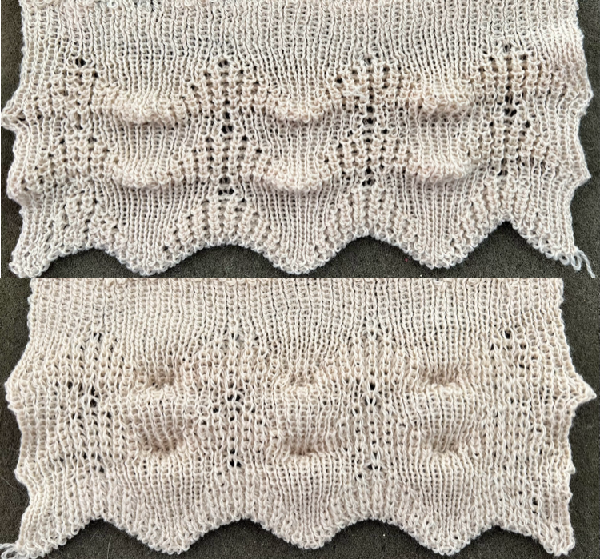 What happens when one is so engrossed with watching stitch formation that the fact that the cone has just run out of yarn is completely missed
What happens when one is so engrossed with watching stitch formation that the fact that the cone has just run out of yarn is completely missed  12X24
12X24 ![]()
 Switching yarn to 2/18 silk wool at the same tension produces knit with a very different density and drape. Light bounces off this yarn interestingly, making it harder to photograph in sharper focus.
Switching yarn to 2/18 silk wool at the same tension produces knit with a very different density and drape. Light bounces off this yarn interestingly, making it harder to photograph in sharper focus. 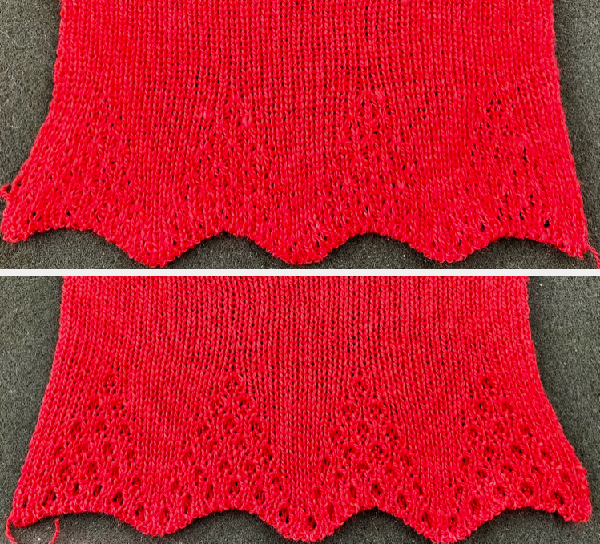 Here the same brand and weight yarn, steamed and pressed lightly, resulting in some flattening of the tuck texture’s 3D effect. Different colors or even different dye-lots of the same color in any yarn can behave differently with all else being equal. The relaxed and stretched view
Here the same brand and weight yarn, steamed and pressed lightly, resulting in some flattening of the tuck texture’s 3D effect. Different colors or even different dye-lots of the same color in any yarn can behave differently with all else being equal. The relaxed and stretched view  and an attempt at showing its ruffling effect.
and an attempt at showing its ruffling effect. 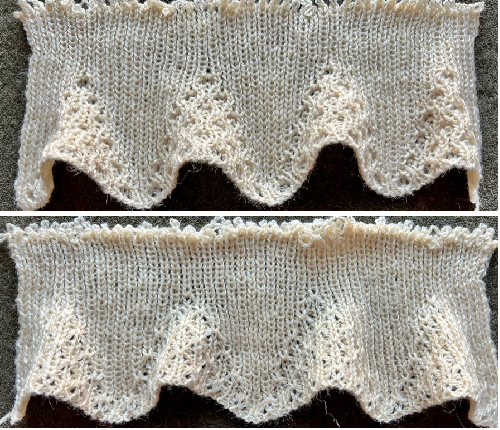 A very interesting surprise: a few years ago during one of my temporary obsessions I developed racked scale-like 3D patterns, this series reflects some of my first attempts
A very interesting surprise: a few years ago during one of my temporary obsessions I developed racked scale-like 3D patterns, this series reflects some of my first attempts 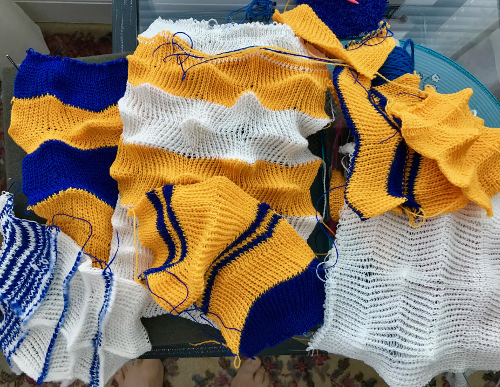 One of several illustrated repeats designed for assistance from needle patterning preselections
One of several illustrated repeats designed for assistance from needle patterning preselections  I wondered whether the triangular repeat for the trim above modified to a diamond shape might produce similar results. The proof of concept swatch was far easier to knit, with no racking, and no critical tracking of all-knit row locations than the every needle rib version.
I wondered whether the triangular repeat for the trim above modified to a diamond shape might produce similar results. The proof of concept swatch was far easier to knit, with no racking, and no critical tracking of all-knit row locations than the every needle rib version.![]()


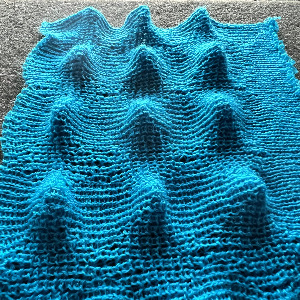 12X24, rendered suitable for punchcard use
12X24, rendered suitable for punchcard use ![]()
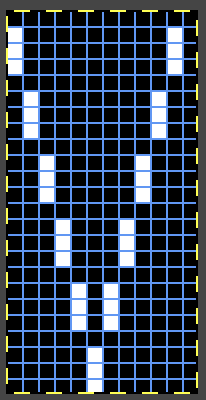 The tiled repeat for a sense of resulting pattern movement
The tiled repeat for a sense of resulting pattern movement 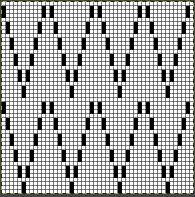 10X24 is missing the single all-knit vertical column seen above
10X24 is missing the single all-knit vertical column seen above ![]()
 also tiled for visualizing the pattern’s movement
also tiled for visualizing the pattern’s movement 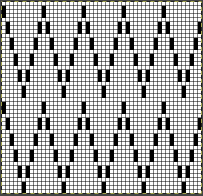 12X12 knit using the tuck setting,
12X12 knit using the tuck setting, ![]()
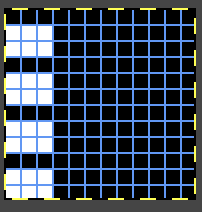
 or the slip stitch setting, making for more subtle results
or the slip stitch setting, making for more subtle results 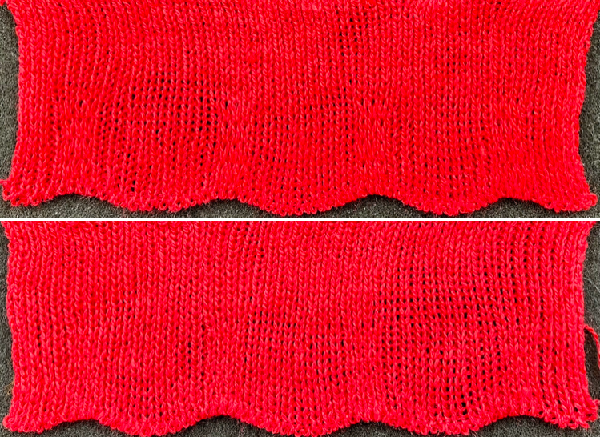
Category: Casting on/binding off double bed
More on standard and modified 1X1 and 2X2 ribs
Ribber manuals usually give instructions and diagrams for ribs, and in some early manuals, the way in which the needles should be set up so that side edges will match the when garment bands are seamed is not included.
In later model manuals, instructions began to call “perfect selvages”.
The position of the beds in relation to each other is dependent on the pitch lever. When both beds are being used, both the pitch and racking levers may be moved so that the ribber can travel one or half turns in either direction. A half turn is sometimes used to set up the position for some accessories, or may simply be what works best in the specific knit fabric and yarn.
If traveling between Japanese brand instructions, some of the names for parts differ.
Brother 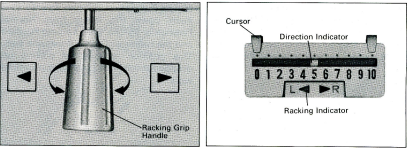 Studio or Silver Reed:
Studio or Silver Reed:
A: half pitch lever, B: swing handle, C: swing indicator  Not leaving out the Passap: the racking handle and racking indicator
Not leaving out the Passap: the racking handle and racking indicator 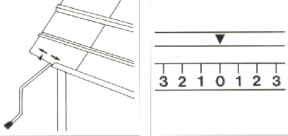 The Passap racking handle moves in a circular direction, clockwise or counterclockwise.
The Passap racking handle moves in a circular direction, clockwise or counterclockwise.
On the Bulky machines, after the zig-zag row, consider ladderback arrangements for less thick and stiff double bed work.
If the bulky rib was to be applied to single-bed work, I was never happy with direct transitions on the machine. Hand-knitters have some advantages when owning a range of needle sizes and types. One option then is to start on waste yarn, end with a row of ravel-cord, and begin the piece on open stitches. Upon its completion, pick up the open stitches on an appropriate size knitting needle, and knit and bind off the rib by hand.
If only the look of the cast-on row is not pleasing, another option can be to start ribbing after waste yarn configured to the necessary needle arrangement, ending with a row of ravel-cord and beginning the rib on open stitches while leaving a length of yarn for binding it off later.
After completing the piece, pick up the open stitches with a small gauge double-point knitting needle for added ease, but use an appropriate size hand knitting needle for binding off in rib configuration.
When choosing to leave a length of yarn for binding off a previously knit piece of fabric, wrap around all needles in work a minimum of four times, wrap it in a small bundle and secure it with yarn or another small tie, or wrap it around a bobbin like those used in embroidery or intarsia.
The third circular row is not needed after the zig-zag row and placement and addition of weights in ribber cast-ons. It actually will form a small float on one side of the fabric that will show if that side becomes the knit face of the finished piece.
That third row is recommended here, as in most pubs, in Brother Ribber Techniques.
The first setup given does not include any transfers between beds 
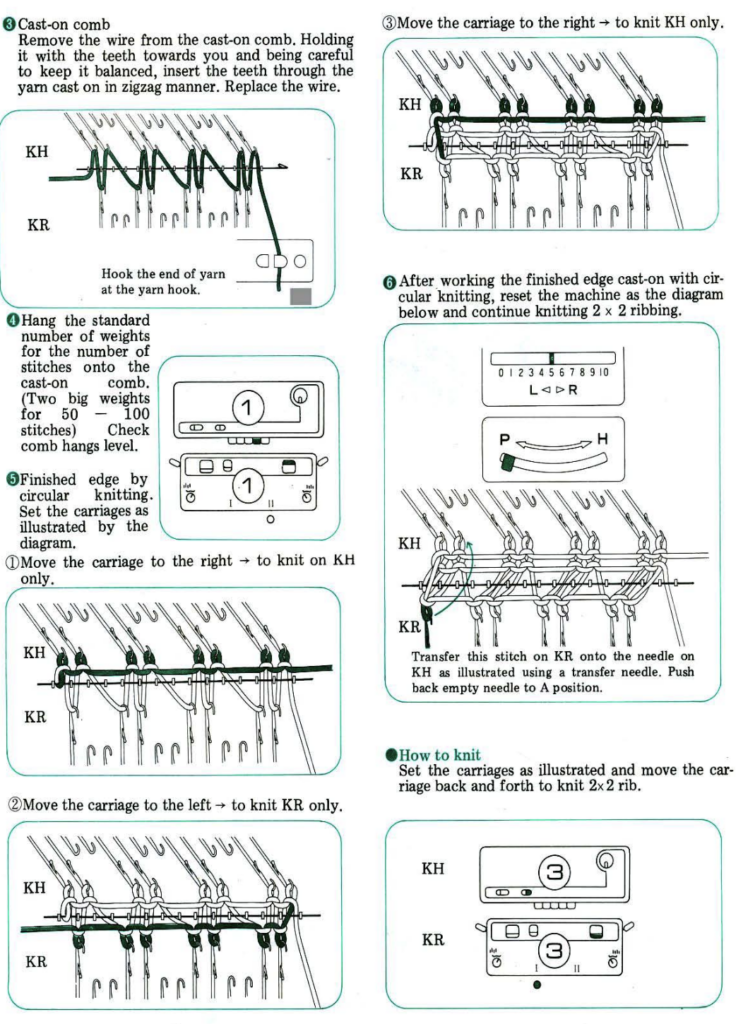
 The rib with transfers recommendation results in a commercial-type rib which is used when the garment is to be knit entirely on double beds or when using fine yarns so that stitches are brought closer together, resulting in less distortion. Its use can make ribbed bands appear narrower than the remaining part of the garment, with no buckling or distortions after the technique change, while allowing the needed stretch.
The rib with transfers recommendation results in a commercial-type rib which is used when the garment is to be knit entirely on double beds or when using fine yarns so that stitches are brought closer together, resulting in less distortion. Its use can make ribbed bands appear narrower than the remaining part of the garment, with no buckling or distortions after the technique change, while allowing the needed stretch.
There are other arrangements that will form ribs that lie flat and make better joins when used ie as bands in cardigan fronts.
Test swatches should include transfers to the final fabric bed arrangement, whether single or double followed by treating the swatch as one would the final piece before calculating the gauge and committing to a garment or even an accessory.
Begin with a zig-zag row and tension suitable for the yarn being used, and knit 2 circular rows.
At this point, stitches are transferred. If the fabric is to be used with the purl side facing transfer stitches on the ribber, for the knit side facing make the transfer on the main bed.
In this post, it is assumed that the knit side will be worn on the outside in each case. Seaming edge stitch allowances are taken into account.
The tension used after any final transfers to the opposite bed will need adjustment based on the yarn thickness, twist, and machine being used. It is wise to begin any experiments with familiar yarns.
The racking lever position is recommended to be set to 5 prior to any cast-on. Other positions may be used as long as the ribber can still be moved by one to one-and-a-half positions to either the right or left if there is any reason to do so. Passap markings are different. When racking I found it easier to mark its bed with my own numbers since I usually work out most of my patterns on Japanese machines. They do not apply if any reader technique racking numbers are in use, since any console prompts are based on the manufacturer’s sequencing. 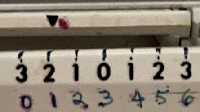 A practical reminder from Silver Reed: do not turn the swing/racking handle on any Japanese machine with all needles up to D on both beds on a serious collision course.
A practical reminder from Silver Reed: do not turn the swing/racking handle on any Japanese machine with all needles up to D on both beds on a serious collision course. 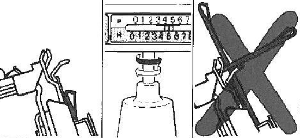 It can sometimes appear easier when making transfers to have needles point to point. If that or another bed adjustment is made to any personal preference, keep the desired final setup in mind, and before continuing to knit, check that the machine is set for half pitch.
It can sometimes appear easier when making transfers to have needles point to point. If that or another bed adjustment is made to any personal preference, keep the desired final setup in mind, and before continuing to knit, check that the machine is set for half pitch.
Prior to casting on bring the main bed needles into work. Bring the same number of needles into work on the ribber, plus an extra needle on the right.
On Half pitch, H, for knit side facing, transfer stitches from the main bed to the ribber for a 1X1 effect. The number of needles in work on the main bed should be a multiple of 2+1. After the transfer, adjust the tension settings. The pitch remains on H ![]() For a 2X2 effect, the cast-on method is the same, with every 3rd stitch transferred down to the ribber. The number of needles on the main bed should be a multiple of 3+2
For a 2X2 effect, the cast-on method is the same, with every 3rd stitch transferred down to the ribber. The number of needles on the main bed should be a multiple of 3+2 ![]() When the band is complete, all stitches may be transferred up to the top bed and the piece continues in single-bed knitting.
When the band is complete, all stitches may be transferred up to the top bed and the piece continues in single-bed knitting.
Straightforward two-by-two bands knit and applied as a long vertical strip will want to curl when joined to a knit. Modified commercial rib variations will produce far better results.
If a sideways application is chosen, after all the stitches are transferred to the top bed, knit a row before applying the band by the chosen method. This row may appear as a stitching line on the finished piece.
Other variations: here the number of needles in work on the top bed must be a multiple of 4 +1
with half pitch on H bring needles into work on both beds ![]() A single needle on each bed seen here on the left, remains in place until the cast on is complete
A single needle on each bed seen here on the left, remains in place until the cast on is complete ![]() the ribber is racked to the left, half pitch now set to P, those 2 end needles on the left of the above chart are moved to make the edges of the work identical
the ribber is racked to the left, half pitch now set to P, those 2 end needles on the left of the above chart are moved to make the edges of the work identical ![]() With a multiple of 3+1 needles in work on the main bed, begin with every needle, on half pitch
With a multiple of 3+1 needles in work on the main bed, begin with every needle, on half pitch ![]() the ribber is moved 1 whole position with the racking lever to the left, the end stitches on the above left are moved so as to produce identical ends.
the ribber is moved 1 whole position with the racking lever to the left, the end stitches on the above left are moved so as to produce identical ends. ![]() The post Seaming, joining, picking up stitches 3, ribbed knits offers suggestions on seaming techniques.
The post Seaming, joining, picking up stitches 3, ribbed knits offers suggestions on seaming techniques.
Vertically worked bands require their own small gauge swatch. The weighing of a small strip is bound to differ from that distributed across a wider band ie that at the waistline, and the results need to be calculated accordingly. The same consideration is a factor in shaped sleeves vs. sweater bodies.
End the bands with waste yarn, then if too many rows have been knit they can be unraveled, or if more are required the stitches may be rehung on the machine for continued knitting.
Apply bands to garment pieces that have been allowed to rest.
Some binding-off methods have been discussed in the post on binding off on the double bed.
Binding off ribbing sparks discussions on which way is best, especially if both the cast-on and bound-off edges are both visible and the hunt is on to get them both to match.
To review, bind-offs may be done in a multitude of ways on the machine by transferring stitches between beds or leaving them where they are, as well as working them after removing the knit from the machine on waste yarn.
Instructions abound in hand-knitting pubs and machine-knitting demonstrators talk about smiles-and-frowns visualizations including in some youtube videos when discussing tapestry needle-sewn bind-offs.
There are techniques that can accomplish similar effects with the knitting still on the machine as long as there is room to jump up several tension numbers before knitting the last row with both carriages from right to left.
The drawback I find using a tapestry needle with the work when it is off the machine is managing the length of yarn necessary in pieces wider than demonstration swatches.
The process may be easier for some if the work is taken off the machine and onto a hand-knitting needle, preferably a double-pointed one with needle stoppers available. Any hand-knitting illustrations or videos then become easier to follow.
With a tapestry needle, one inserts the needle as if to purl into the first (knit, cyan) stitch and as if to knit on the second (purl, yellow), both stitches are left on the needle.
The first stitch is then “knit off” and the needle is inserted into the next stitch (knit) as if to purl. Both stitches are left on the needle. Repeat steps 1 and 2. I used to suggest my students think up ditties for repeated actions, here it might be “purl into a knit and knit into a purl”.  The steps after the work is scrapped off on waste yarn
The steps after the work is scrapped off on waste yarn 
 bring up discussions on how best to scrap off.
bring up discussions on how best to scrap off.
The missing how-to preparation for binding off:  When the rib is completed, transfer the stitches on the ribber up to the main bed, pulling needles out to E as you move across the bed
When the rib is completed, transfer the stitches on the ribber up to the main bed, pulling needles out to E as you move across the bed
 Cut the yarn, leaving an end long enough for binding off.
Cut the yarn, leaving an end long enough for binding off.
Remove the ribber arm, exchange it for the standard sinker plate, place a contrasting color yarn in feeder A and secure it.
My test piece ended COR. Push in the cam button for slip stitch corresponding to the direction in which the carriage will move on its next pass, in this case, the left one. Another option is to simply push in both.
As the carriage moves to the opposite side, what is now identified as knit stitches will knit, and the B position needles will be skipped, creating a float.  Knit at least 10 rows in the contrast yarn. No ravel cord is needed as knitting ravels down easily to be removed.
Knit at least 10 rows in the contrast yarn. No ravel cord is needed as knitting ravels down easily to be removed.  When the piece is scrapped off, the all knit rows will roll nicely to the back of the swatch, and the rib can be stretched easily, with the top of the knit and purl stitches easily identified for sewing.
When the piece is scrapped off, the all knit rows will roll nicely to the back of the swatch, and the rib can be stretched easily, with the top of the knit and purl stitches easily identified for sewing.  Two by 2 ribs with stitches transferred to a hand-knitting needle:
Two by 2 ribs with stitches transferred to a hand-knitting needle: 
 Using the same waste yarn scrap off keeping as for the one-by-one rib, but keeping the two-by-two needle arrangements when setting the knit carriage cam buttons to slip:
Using the same waste yarn scrap off keeping as for the one-by-one rib, but keeping the two-by-two needle arrangements when setting the knit carriage cam buttons to slip: 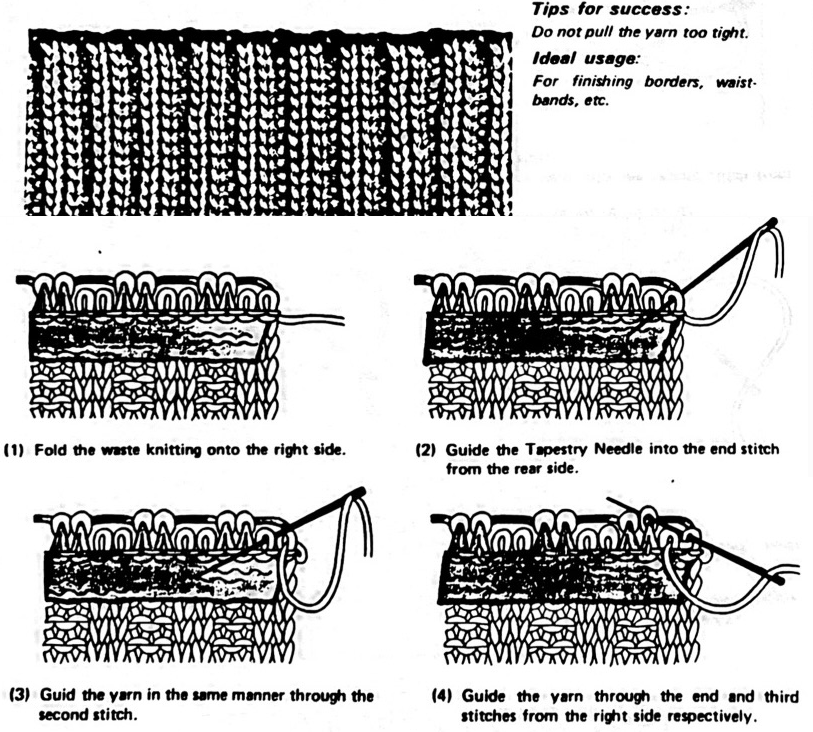

The collection of posts on casting on, binding off, and seaming ribs
Casting on, double bed
Ribber cast ons: breaking the “rules”
Picot cast on for every needle rib
Racked ribber cast on and rib configuration tips
Ribber trims 3: one trim, four variations
Ribber trims 2
Ribber trims/edgings 1
HK trim as MK edging
Binding off, double bed
More shapes on ribber fabrics with tuck patterning, fantasy fair isle
Seaming, joining and picking up stitches 3, ribbed knits
Twisted headband meet fisherman rib, seaming, variation ideas
Seaming, joining, and picking up stitches on knits 2
Transitions in ribbing from EON to FNR fabrics
When no ribber is available, single-bed mock rib
More shapes on ribber fabrics with tuck patterning, fantasy fair isle
Fantasy fair isle is the term often used to refer to dbj fabrics created using tuck settings on either or both beds. Typically in the required color separation used each design row in the repeat is expanded into 4 rows, with the same selection occurring for each color pair of consecutive rows. A tuck/plain combination is used here, with the backing essentially being a striper one, where each color knits every stitch on the ribber on every row.
In this illustration, the blue symbols represent knit stitches on either bed, the red, the tucked stitches on the top bed. The chart represents a single design row expanded into 4, the results would, in turn, be rendered double length in knitting the final fabric.  The last post related to this topic: 2021/09/07/geometric-shapes-on-ribber-fabrics-with-tuck-stitches-3/
The last post related to this topic: 2021/09/07/geometric-shapes-on-ribber-fabrics-with-tuck-stitches-3/
Recently a friend shared images of a punchcard skull pattern she was using in a hat and followed with a query as to the possibility of using the pattern on a mesh grid. The inspiration for the conversation began with this image, the work of Claudia Scarpa.  The possibility of adding images on a true mesh transfer lace or mesh-like thread lace images may be found in 2021/12/14/to-mesh-or-not-to-mesh-9-more-on-mock-filet-design/
The possibility of adding images on a true mesh transfer lace or mesh-like thread lace images may be found in 2021/12/14/to-mesh-or-not-to-mesh-9-more-on-mock-filet-design/
My DIY skull image in a potential thread lace pattern, in a 100X92 pixel png.  Concurrently the topic of illusion knits on the machine has also resurfaced in FB with some spectacular panels executed using the Garter carriage and changing colors every 2 rows. Some small geometric shapes begin to have a somewhat “similar” appearance using this technique, but as with beauty, the success in the imitation is in the eye of the beholder.
Concurrently the topic of illusion knits on the machine has also resurfaced in FB with some spectacular panels executed using the Garter carriage and changing colors every 2 rows. Some small geometric shapes begin to have a somewhat “similar” appearance using this technique, but as with beauty, the success in the imitation is in the eye of the beholder.
The techniques involved: my proof of concept was knit using img2track on a 930. Traditionally two-color designs may be opened and then downloaded, using the standard dbj built-in KRC function for the color separation, not suitable for this dbj version, while for designs in 3 or more colors the program will separate the repeat in a way that each color for each design row is knit twice, the separation required here.
At this point, the color separation is executed by filling in pixels and observing a variety of rules. DAK produces templates of jacquard separations of varied types that may be printed for use outside its universe. The same file may be screengrabbed, traced, and redrawn pixel by pixel for use in a Brother download using other download software.
Passap by default separates knits for 2 color DBJ with each color for each design row knitting twice mode. Tucking on either or both beds is made easier because of the way stitches are formed on the Passap beds, along with the use of strippers which push down on tuck loops with each pass, ensuring that they will knit off properly. The fabric widens considerably when off the machine, requiring loose cast-ons and bind-offs. The dbj variant, dubbed fantasy fair isle, is often used to create lap or quilt blankets.
The Passap built-in reader techniques that are often recommended for large knit pieces ie blankets using the same design are 186 for throw size, 187 for lap blankets, and 183 for crib quilts. All three share the fact that the front bed pushers are selected in pattern in the up/knitting position alternating with the down/slip/tuck position alternating every 2 rows, producing the jacquard discussed here.
Slip settings produce narrow, short results, tuck short and wide ones. For non-Passap knitters, N is Passapese for plain knit, KX is tuck with patterning on the front/ knit bed, and AX for tuck patterning on the back/ribber bed.
Back in 2018, I began another post I meant to return to on traveling between the two brands.
My Passap E6000 manual is filled with scribbled notes from decades ago, expanding on how each technique may be used for a variety of fabrics. 
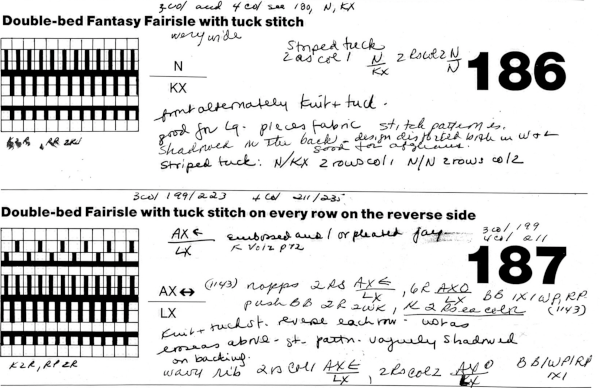 In Fantasy Fairisle knitting using 187 with alternating up and down pushers on the back bed and AX with 2 arrow keys would match Brother ribber knitting with lili buttons used on an even number of needles set to tuck.
In Fantasy Fairisle knitting using 187 with alternating up and down pushers on the back bed and AX with 2 arrow keys would match Brother ribber knitting with lili buttons used on an even number of needles set to tuck.
Working with the large skull image the setting of knit every row on the ribber and tuck in both directions on the knit bed is used as in technique 186, with a critical difference. Passap knitters may download the original black and white image while for Brother knitting a color separation is required.
The original skull image is 100 pixels wide by 92 high.
Converting the white ground layer behind the skull to alpha produces an image on a clear ground that can be placed exactly where desired on a new file with a white ground using the grid and guides
The alpha double long skull, now 100 by 184 pixels  For the 1-pixel grid in Gimp to be visible on an editable image, a magnification of at least 800 is required. The options offered by default
For the 1-pixel grid in Gimp to be visible on an editable image, a magnification of at least 800 is required. The options offered by default
 can be changed to suit by simply typing in a new number.
can be changed to suit by simply typing in a new number.
As described in other posts including in Gimp update for Mac2, I chose to mark every other row with a red pixel, making it easier to track color-inverting every other row. This is achieved by selecting the rows with red dots using the rectangle tool one row at a time and choosing Invert from the colors menu. The red dot will also change color, making it easy to locate converted rows in more complex patterns. The dotted blue line is a guide for placement.  in progress
in progress  the processed image
the processed image  the trimmed 98X182 png
the trimmed 98X182 png  doubled in length once more to 98X364
doubled in length once more to 98X364  Knitting process on a 930 using img2track:
Knitting process on a 930 using img2track:
the 930 has a tiny brain, so the image is broken down by the software into multiple tracks of 96, 134, and 134 respectively. One of the critical differences when using this type of DBJ color separation is that the first preselection row is made from right to left toward the color changer rather than from left to right as in KRC separated 2 colors DBJ.
The first and last needles are in work on the ribber to ensure the edge stitch on that bed will knit every row.
The knit carriage is set to KCII, canceling the end needle selection.
Once the first row has been preselected and the planned color is chosen, with COL, set the main bed to tuck in both directions, leave the ribber set to knit, and continue knitting changing color every 2 rows.
In my swatch, the dark contrast color was used for the initial black pixel all-knit rows.
The work on the machine:  A reminder: in my experience, the Brother cast-on combs are usually chrome-colored, Studio grey, and Passap, and I believe Superba ones were traditionally green. The first 2 were designed for 4.5 mm machines, the latter for 5mm. The different mm spacing does not make the 5 mm combs suitable for casting on on Brother, but they can be poked through the knit in progress. I like to leave the first comb and weights on, insert the new comb closer to the beds, and then move the weight up, and then remove the lower position comb.
A reminder: in my experience, the Brother cast-on combs are usually chrome-colored, Studio grey, and Passap, and I believe Superba ones were traditionally green. The first 2 were designed for 4.5 mm machines, the latter for 5mm. The different mm spacing does not make the 5 mm combs suitable for casting on on Brother, but they can be poked through the knit in progress. I like to leave the first comb and weights on, insert the new comb closer to the beds, and then move the weight up, and then remove the lower position comb.
There are lots of side-by-side stitches tucking on the main bed, made possible by the fact that each is anchored in place by a knit stitch on the opposite bed.
The tension needs to be set so that the stitches will knit off properly while having tuck loops not so loose as to get hung up on gate pegs. It can take a bit of trial and error to find proper settings and they, in turn, may need to be adjusted again when moving from small swatches to knitting on a far larger number of needles.
The finished piece measures 25 inches in width by 24 in height.
The appearance on the bed set to N, in this case, the ribber:  Those white lines on the right are spots where the color changer picked up both color threads, a problem that does not occur in Passap knitting, where each color is picked up in its own yarn holder.
Those white lines on the right are spots where the color changer picked up both color threads, a problem that does not occur in Passap knitting, where each color is picked up in its own yarn holder. 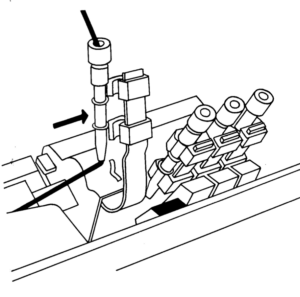 In the Brother model, sometimes the yarn is left in the wrong place below eye level rather than its own individual one corresponding to its button, and both yarns are picked up with the next color change.
In the Brother model, sometimes the yarn is left in the wrong place below eye level rather than its own individual one corresponding to its button, and both yarns are picked up with the next color change.  The more textured knit side of the piece,
The more textured knit side of the piece,  a close-up of the texture at an angle
a close-up of the texture at an angle  Claudia Scarpa developed a skull variation using only layers in Gimp
Claudia Scarpa developed a skull variation using only layers in Gimp 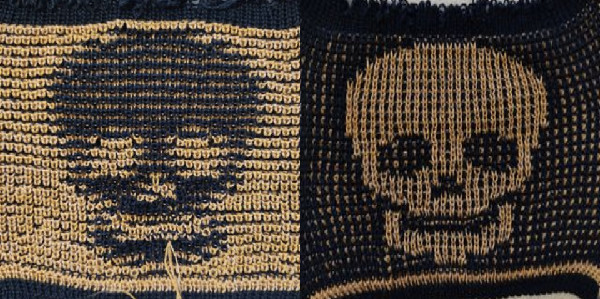 and has been kind enough to create a Youtube video illustrating the process. The separation is easy and quick as opposed to my more prolonged hack, and I will return to attempt to use it for various fabrics in a follow-up post.
and has been kind enough to create a Youtube video illustrating the process. The separation is easy and quick as opposed to my more prolonged hack, and I will return to attempt to use it for various fabrics in a follow-up post.
This skull is more compact and better defined than mine. With the double-long original image superimposed on alternating pairs of black and white rows, the resulting png can not be lengthened again as tucking would then occur for 4 rows, not likely possible in a Brother machine. The variant is a very interesting cousin to mine.
In DAK using Method C color separation each color row separates into 2 rows of knitting and when using the result rows do not have to be repeated in pairs but the double-length switch will need to be used in Japanese knitting machines if working within the program. For those intending to use the separation outside the DAK universe, the color separation may be printed, traced/redrawn to create a png or bmp, scaled double length, and used as in the skull swatch. The template for the double long triangle in the post and the associated 24 stitches by 32 rows png, followed by the associated drawn png 
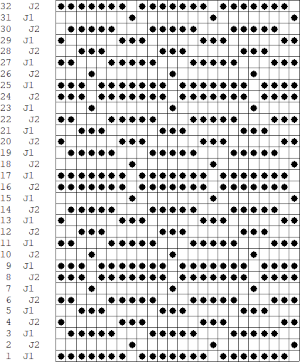
![]() The png doubled in length, 24 stitches by 64 rows.
The png doubled in length, 24 stitches by 64 rows. ![]() This is a small repeat, suitable for punch card machines. The test swatch is knit with the main bed tucking both ways and the ribber knitting every row.
This is a small repeat, suitable for punch card machines. The test swatch is knit with the main bed tucking both ways and the ribber knitting every row.  It is possible to work some repeats on some machines with the ribber also set to tuck both ways with EON needle selection.
It is possible to work some repeats on some machines with the ribber also set to tuck both ways with EON needle selection.
In Brother that is achieved by using lili buttons with an even number of needles in work on the ribber. The first and the last needle would be in work on the top bed, the KCI setting is used for end needle selection to ensure that the first and last needles on each side of the piece will knit. I did not find this method workable and soon had to stop because of a loopy mess. 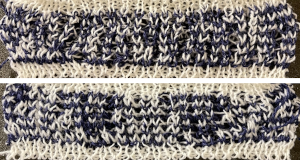 When using the Dak stitch design module, the color separation is automated. Choose any design repeat. This happens to be a 20X20 one, chosen from the thumbnail assortment, so not suitable for punchcard models. “Printing” the template using choosing the option of using dots rather than squares to represent knit stitches makes the resulting print screengrab easier to trace.
When using the Dak stitch design module, the color separation is automated. Choose any design repeat. This happens to be a 20X20 one, chosen from the thumbnail assortment, so not suitable for punchcard models. “Printing” the template using choosing the option of using dots rather than squares to represent knit stitches makes the resulting print screengrab easier to trace. 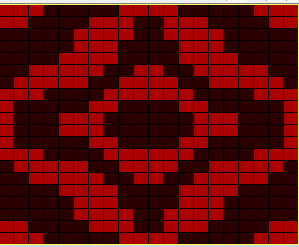 the 20X20 repeat as a BW png
the 20X20 repeat as a BW png ![]() The template was overlayed with a grid in numbers, filling in cells over the dotted areas.
The template was overlayed with a grid in numbers, filling in cells over the dotted areas.
A portion of the work in progress using the generated dbj option C template and tracing it transitioning from template to Numbers, to Gimp:  The result is screengrabbed, opened in Gimp, converted to BW mode, and scaled to the 20X40 expanded design size. Unless the double-length function in the machine is also used, it will need scaling again to double length prior to download.
The result is screengrabbed, opened in Gimp, converted to BW mode, and scaled to the 20X40 expanded design size. Unless the double-length function in the machine is also used, it will need scaling again to double length prior to download.
Illustrations for the generated dbj option C template, tracing it in Numbers, processed in Gimp,  The final image double length, showing the difference between the separation using the template, and that using layers as in Claudia’s video, which appears different but is actually the same repeat, color reversed.
The final image double length, showing the difference between the separation using the template, and that using layers as in Claudia’s video, which appears different but is actually the same repeat, color reversed. 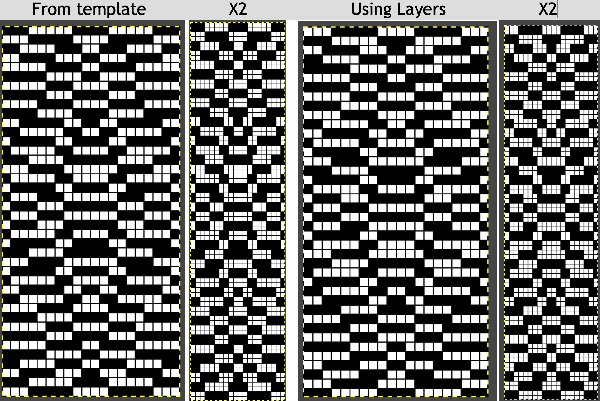 Using bucket fill for the ground in the second layer, as described in the video, the captured clipboard image can be very small
Using bucket fill for the ground in the second layer, as described in the video, the captured clipboard image can be very small 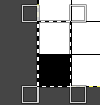 or stripes any width may be captured, even up to that of the full repeat width
or stripes any width may be captured, even up to that of the full repeat width![]() Remember to click on the screen outside the area chosen with the rectangle tool before using the bucket fill in pattern tool.
Remember to click on the screen outside the area chosen with the rectangle tool before using the bucket fill in pattern tool.
The result is the same using either brush.
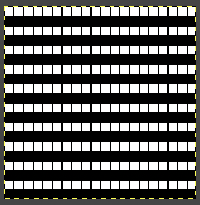 Alternately, the initial design may be scaled X4 to 20 X 80 pixels
Alternately, the initial design may be scaled X4 to 20 X 80 pixels ![]() and it is superimposed on a ground flood-filled with 2 black rows alternating with 2 white rows
and it is superimposed on a ground flood-filled with 2 black rows alternating with 2 white rows  the steps resulting in a match to the previous elongated version
the steps resulting in a match to the previous elongated version 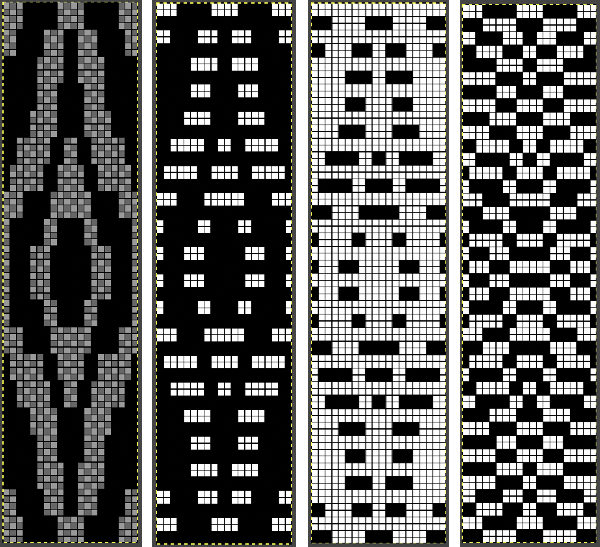 the 20X80 png
the 20X80 png ![]() In the related swatch patterning is used on 40 stitches by 100 rows. The relaxed fabric when off the machine measures 7 inches by 7 inches and the knit side view reflects the elongation of the design one might observe when using the same color separation in standard striper-backed DBJ. On the bottom, the swatch is stretched and the stitches are set with some casual steaming and pressing to 10.5 to 6.75 inches, gaining the familiar texture appearance seen in so many Passap blankets.
In the related swatch patterning is used on 40 stitches by 100 rows. The relaxed fabric when off the machine measures 7 inches by 7 inches and the knit side view reflects the elongation of the design one might observe when using the same color separation in standard striper-backed DBJ. On the bottom, the swatch is stretched and the stitches are set with some casual steaming and pressing to 10.5 to 6.75 inches, gaining the familiar texture appearance seen in so many Passap blankets.
The color differences are due to lighting, with the photos being taken at different times of day.  For a loose cast-on row, I used a racked version at the same tension as the body of the knit.
For a loose cast-on row, I used a racked version at the same tension as the body of the knit.
For a loose bind-off to accommodate the stretch, I used this method, one of many taught in Passap seminars.
To perform the same on Brother machines: knit the piece, ending with the carriages on the right.
Transfer all the stitches up to the top bed,  bring the ribber needles up into work between them
bring the ribber needles up into work between them  set the ribber to a looser tension number, here it was increased from 4 to 7. Knit one row from right to left, picking up loops on the empty ribber needles
set the ribber to a looser tension number, here it was increased from 4 to 7. Knit one row from right to left, picking up loops on the empty ribber needles  drop the ribber slightly by using this bracket lever position to elongate the main bed stitches.
drop the ribber slightly by using this bracket lever position to elongate the main bed stitches. 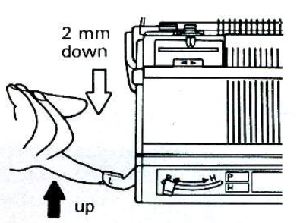 Using a latch tool, beginning with the first stitch on the right, insert the open latch tool into the first stitch on the right, then insert it into the second stitch moving down until the first stitch is behind the hook. Do not allow the second stitch to go behind the latch, keep it in the hook. Pull the latch hook up moving the second stitch through the one behind it, forming the first chain. Repeat across the row, going through the center of each stitch, continuing the chained bind-off.
Using a latch tool, beginning with the first stitch on the right, insert the open latch tool into the first stitch on the right, then insert it into the second stitch moving down until the first stitch is behind the hook. Do not allow the second stitch to go behind the latch, keep it in the hook. Pull the latch hook up moving the second stitch through the one behind it, forming the first chain. Repeat across the row, going through the center of each stitch, continuing the chained bind-off. 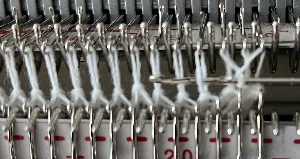 A yarn end is pulled through the last stitch and the now completed chained row is secured
A yarn end is pulled through the last stitch and the now completed chained row is secured  The beds are returned to the up position, and loops and stitches are dropped off all the needles.
The beds are returned to the up position, and loops and stitches are dropped off all the needles.
An attempt at a more detailed look at the bound-off edge
Ribber cast ons: breaking the “rules”
This is a quick note attempting to illustrate the third circular row as shown in manuals is not needed and in some yarns, at least to my eye, there is an extra “bar/float” making a difference between the purl and knit side of the fabric. I find the 2 circular rows also make a bit tidier, tighter edge. My swatches are very small, in fine 2/18 silk wool.
This is the purl side facing, 2 circs on left, 3 on the right  the knit side, 2 circs on left, 3 on the right
the knit side, 2 circs on left, 3 on the right  every other needle, purl side facing, 2 circs on left, 3 on the right, with markers indicating the “extra float”
every other needle, purl side facing, 2 circs on left, 3 on the right, with markers indicating the “extra float”  the knit side, 2 circs on left, 3 on the right
the knit side, 2 circs on left, 3 on the right  I knit the samples as tightly as possible. When making dbj slip stitch scarves I wanted the bottom to match the top in width. The ribber stitches were transferred to the main bed and tested on a test swatch whether I preferred to knit an added row or not before performing a latch tool bind off around gate pegs. To deal with the cast on width, I simply planned to knit the zig-zag row on at least garment tension, thus leaving me with what are normally considered ugly loops. There are 2 such loops for each stitch. With a latch tool, begin opposite the yarn end, and consistently choose the next right or left loop, chaining them through each other.
I knit the samples as tightly as possible. When making dbj slip stitch scarves I wanted the bottom to match the top in width. The ribber stitches were transferred to the main bed and tested on a test swatch whether I preferred to knit an added row or not before performing a latch tool bind off around gate pegs. To deal with the cast on width, I simply planned to knit the zig-zag row on at least garment tension, thus leaving me with what are normally considered ugly loops. There are 2 such loops for each stitch. With a latch tool, begin opposite the yarn end, and consistently choose the next right or left loop, chaining them through each other.
Two circular rows are also used when transitioning from varied configurations to every needle ones, illustrated in the post on racked-ribber-cast-on-and-rib-configuration-tips
picking up an edge loop, moving it behind the latch  proceeding toward the yarn end, pick up one of the next 2 loops in the hook, here I consistently chose the one on the right
proceeding toward the yarn end, pick up one of the next 2 loops in the hook, here I consistently chose the one on the right  if the first loop slips in the hook again as well, get it behind the latch once more before proceeding
if the first loop slips in the hook again as well, get it behind the latch once more before proceeding
 pull the second loop through the previous one
pull the second loop through the previous one 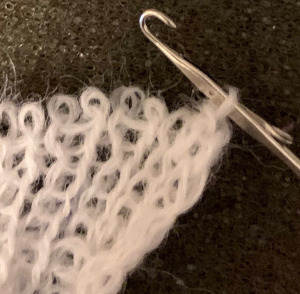 work across the row, secure the yarn end
work across the row, secure the yarn end 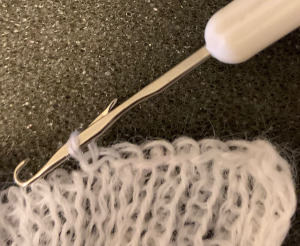 the appearance on the reverse side
the appearance on the reverse side  I can be a little bonkers with my finishing, have even been known when dealing with getting top and bottom edges to match in look and width to rehang every other loop, knit a row, and then perform the latch tool bind off. If tuck double bed fabrics are knit, they require planning for loose cast-ons and bind-offs. Slip stitch is short and thin, tuck stitch is short and fat, whether knit single or double bed and then is compared with fabrics where either bed predominantly knits plain.
I can be a little bonkers with my finishing, have even been known when dealing with getting top and bottom edges to match in look and width to rehang every other loop, knit a row, and then perform the latch tool bind off. If tuck double bed fabrics are knit, they require planning for loose cast-ons and bind-offs. Slip stitch is short and thin, tuck stitch is short and fat, whether knit single or double bed and then is compared with fabrics where either bed predominantly knits plain.
For a cast-on intended to have a more flared edge see 2015/11/25/picot-cast-on-for-every-needle-rib/
Twisted headband meet fisherman rib, seaming, variation ideas
The machine knitting forums in both Ravelry and Facebook have recently been buzzing with versions of twisted headbands in varied techniques and yarn weights. Tanya Cunningham sparked the discussions by showing her bulky tubular knotted version. In her blog, one may find clear instructions on fold and assembly.
I chose to knit mine in full fisherman rib, making the fabric reversible, so that facing side at the start did not matter when seaming. I wanted a single thickness and a lightweight but warm fabric that would lie flat, perhaps being worn under jacket hoods on winter walks. My first band was knit with a punchcard carriage with a magnet placed for using it on my electronic. I forgot I had removed its row counter when it was last used for knitting with 2 paired main/ribber carriages in order to clear the end of the bed. As a result, I was unable to use the row counter, as that fact eliminated the tripper for it.
Part of my plan was also to avoid bulk at the twist as much as possible. Increasing the stitch count for such warmers can easily approach more of a hat shape, and a “top” could be added to complete the piece if it is intended to be worn as one.
In terms of inspiration, there are endless sources for twisted bands available, most for hand knitting, but sometimes they can be adapted to machine knitting easily enough, especially if one also owns a G carriage. One such source is Dropsdesign , simply enter headbands, knit, in the search field.
Head sizes and what each of us determines as comfort can vary tremendously. A table of head circumferences may be found at craft yarn council, and for much more detailed charts see
The twist will take up some of the finished lengths.
My first band sailed through on my Brother 930 standard:
Cast on 22 stitches in 2/18 silk wool, tension 5/4, at the same tension as the body of the band, intentionally loose.
Knit to head circumference, checking the length on the machine with weight off periodically after weight hits floor (scientific measurement), and periodically after the weight and comb are moved up.
Transfer stitches to main bed
Knit one row single bed at a looser tension (I used 8 in this version)
Bind off around gate pegs, OK if tighter than the bottom, it will be part of the seam
Twist and fold, rehang one side of the chain, alternate loops from the loose cast on
Knit a loose row across all layers and bind off,
Turn inside out.
Variations in color are due to the wonderful lighting in my apartment on another gloomy, rainy winter fall day.
Visualizing the necessary folds: make certain not to twist the fabric, fold it in half. Colors are used to represent portions of the finished, continuous rectangle, dotted lines the approximate center line when it is folded



For my second effort, I switched the yarn to a yummy feeling 2/14 wool that was plagued with random dropped stitches on the Brother, no matter what I tried. That piece wound up lightly felted by hand after intentionally adding more knit length. I eventually gave up and moved over to my Passap, where things went smoothly knitting on 4/4. A reminder: in this fabric, one bed knits every needle while the opposite bed makes loops on every needle. It is helpful if the first stitch on each bed knits as carriages move to the opposite side.
Passap setting EX/ EX beginning on right and moving toward the left will tuck on the back bed (ribber setting), knit on the front (main bed setting) while tucking on front and knitting on the back when moving from left to right. Operating from the same side, the Brother settings to match would actually be the reverse of those illustrated in the ribber manual. Starting sides are in Brother instructions are often based on cast ons with 3 circular rows. I prefer 2 as I have explained in the past, it avoids a float forming between stitches on one side of the fabric. In this instance, it matters in set up only in terms of planning ahead as to which bed will form knit stitches first and having the first needle in work on that bed to ensure that the stitch will knit. In matching patterns between brands, cam settings could matter more. End needle selection brings stitches out to knit in patterning, but if KC is used here, all needles in work will be brought out to knitting position, so that is not a solution for having those stitches knit. Another thing to note in the instructions is one that might be missed upon a quick view. The Brother setting shown is for full pitch. That is because their instructions are for full fisherman knit for when every other needle is in use. If every needle were in use, the setting should be on H, not P  There is also the option when one wants to insure end stitches knit in patterns such as tuck to bring end stitches out to hold manually prior to knitting the next row.
There is also the option when one wants to insure end stitches knit in patterns such as tuck to bring end stitches out to hold manually prior to knitting the next row.
A gauge swatch in double bed tuck should be at least 80-100 rows in length. One can sometimes “wing it”. It is important if you do that, that the length is measured between the beds as close to needles as possible, and down from there without weight and after the fabric has relaxed. Do not assume it will stretch to fit, the result may be several inches too small.
A comfortable length for me in the blue wool consisted of 310 rows, knit at T 4/4. Stitches were quite small, so after transfer to the back bed, I knit a row to the opposite side at tension 8 before binding off. I also placed contrasting color yarn markers at the center point of the cast on and bind off to make seaming up evenly easier, and held things together with a double eye tool so as not to accidentally twist the piece.
The number 4 band is my first sample, knit on Brother standard. Number one got pulled on to the planned length based on the “it will stretch” assumption. A metal ruler/yardstick was marked with tape at the desired height, while on the machine the marker was reached, but when off it, the final measurement was a whole 16 inches as the knit relaxed, far too small for most human adults! Number 2 is the brother version felted by hand to hide dropped stitch and edge stitch repairs, knit and shrunk to a measurement longer than head circumference for finished width, taking into consideration the fact that stretch is lost in felting. The fit was tested on my own head during shrinking and before drying. The number 3 band is the “comfy wool” one knit on my Passap.  When I taught my course, after weeks of swatching the first “garment” involving a variety of automatic and hand techniques, students were required to knit a “baby hat with earflaps” exactly as given in printed instructions, using any stitch pattern and yarn of their choice. It provided an interesting exercise in gauge and proof of the need for swatching before beginning plans for actual garments. The results varied from so small the hats would only fit a small doll to ones too large for any human head.
When I taught my course, after weeks of swatching the first “garment” involving a variety of automatic and hand techniques, students were required to knit a “baby hat with earflaps” exactly as given in printed instructions, using any stitch pattern and yarn of their choice. It provided an interesting exercise in gauge and proof of the need for swatching before beginning plans for actual garments. The results varied from so small the hats would only fit a small doll to ones too large for any human head.
Knitters are often resistant to swatching, but making assumptions about results can result in not the best use of both time and materials. If working in tubular stocking stitch the tension used should be the same as for knitting of that yarn in that stitch single bed. Tuck stitch is short and fat. In every needle rib there are stitches being worked on both beds, so double the number on the top bed would be actually worked than when using needles on only one bed. Loosening the tension by several numbers on both beds does not equate to matching width for similar numbers of stitches to the ribbed version. Here is a resulting mini-band, testing the same seaming technique used in the fisherman-rib samples. It was 20 stitches in width, 80 rows in length. I cast on at a loose tension, matching that used in the body of the stocking stitch tube and knit a row to seal before setting for circular knitting. When the top is reached, transfer stitches from the ribber to the top bed, knit at a looser tension tow to the opposite side prior to binding off and seaming (here I used 10). The technique should be usable on bulkier bands as well.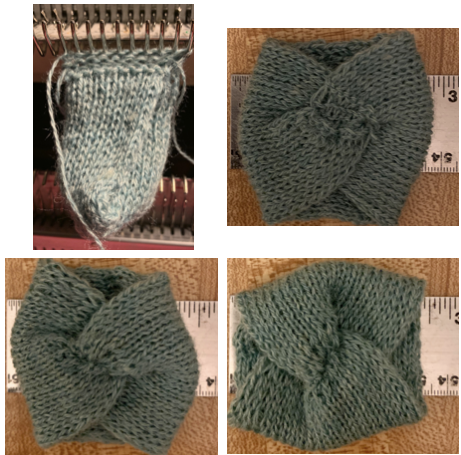 The elongated stitches at the top of the “band” are due to an extra needle in use on the ribber. To review, the proper settings from the Ribber Techniques Book:
The elongated stitches at the top of the “band” are due to an extra needle in use on the ribber. To review, the proper settings from the Ribber Techniques Book: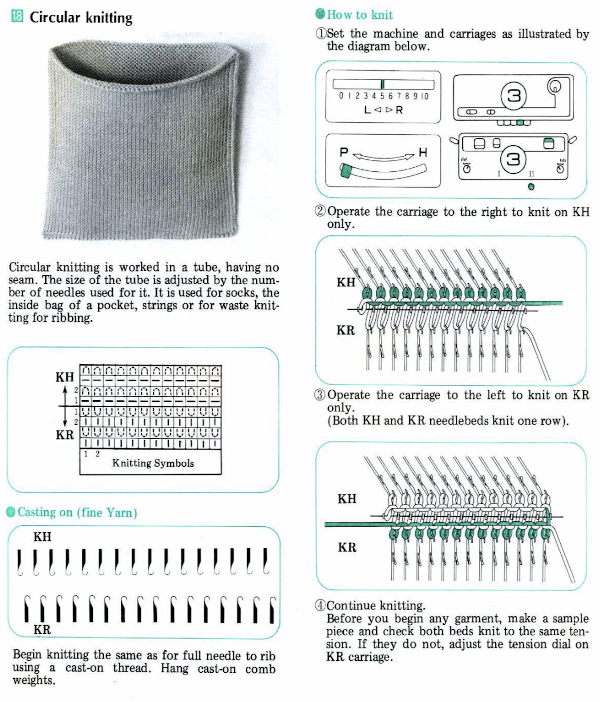
Ribber trims 3: one trim, four variations
I found this on a random sheet tucked away with references from some seminar or other eons ago, its origin is not known to me
 I like to chart out my repeats and plans for executing fabrics, along with ideas for possibly varying them in ways other than suggested, this was my beginning
I like to chart out my repeats and plans for executing fabrics, along with ideas for possibly varying them in ways other than suggested, this was my beginning  The sequence in photos, beginning with the cast on, 2/24 acrylic yarn, zigzag row with inserted ribber comb, half-pitch
The sequence in photos, beginning with the cast on, 2/24 acrylic yarn, zigzag row with inserted ribber comb, half-pitch  1 row is knit across all stitches to complete cast on,
1 row is knit across all stitches to complete cast on, 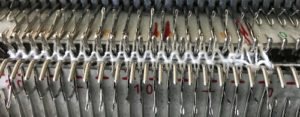 knit one more row to return to the opposite side
knit one more row to return to the opposite side  the setting is changed to full pitch, stitches are transferred between beds to match diagrams
the setting is changed to full pitch, stitches are transferred between beds to match diagrams  the center needle in each group of 3 is brought out to hold for one row, knit one row to return to the other side
the center needle in each group of 3 is brought out to hold for one row, knit one row to return to the other side  center needles are pushed back to D position in order to be knit on return pass to the opposite side
center needles are pushed back to D position in order to be knit on return pass to the opposite side  this tool makes that needle selection faster and easier
this tool makes that needle selection faster and easier  when the 20 rows had been knit in pattern drop stitches on each side of center stitch
when the 20 rows had been knit in pattern drop stitches on each side of center stitch 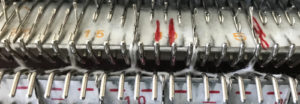 transfer ribber stitches up to main bed
transfer ribber stitches up to main bed 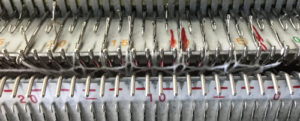 I knit 3 rows rather than 2, to return to right side for bind off
I knit 3 rows rather than 2, to return to right side for bind off 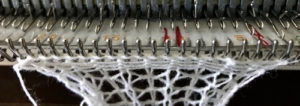 here is the swatch, still on comb for “setting stitches”
here is the swatch, still on comb for “setting stitches”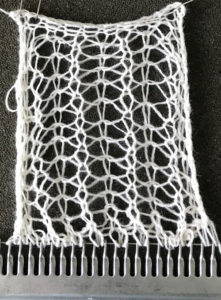

I found the above results upon completion disappointingly wimpy, then tried the same steps in tightly twisted and slightly thicker cotton, achieved better results, but was still not happy. That set me thinking about an alternative way to produce a similar fabric with changes in needle arrangements. The full series of swatches is seen below. The yellow is knit in a 2/8 wool, the beige in the same weight cotton as the white on the right. All swatches were knit on the same tension, for the same number of rows.
The adjustments on the original pattern are as follows. At half-pitch begin as above with zig zag to left, 2 circular rows, knit back to right. Set pitch to P, transfer between beds
 knit back to the opposite side, transfer each of the side stitches on the top bed onto the center needle in each group,
knit back to the opposite side, transfer each of the side stitches on the top bed onto the center needle in each group,
 bring those needles out to hold for easier knitting on the next pass
bring those needles out to hold for easier knitting on the next pass 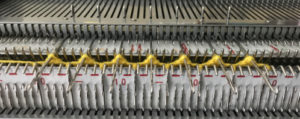 knit one row back to the right, making sure stitches have knit off properly. When you have returned to the right side, set the carriage to tuck from right to left only (left tuck button), RC000
knit one row back to the right, making sure stitches have knit off properly. When you have returned to the right side, set the carriage to tuck from right to left only (left tuck button), RC000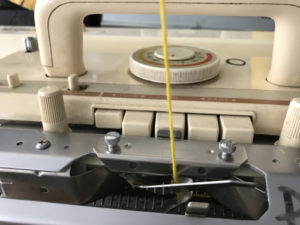 loops will be formed on the center needles as they would have been formed over the needles as if holding was in use
loops will be formed on the center needles as they would have been formed over the needles as if holding was in use
 when the 20 rows are completed the carriages will once again be on the right, all stitches will have been knit on the previous row
when the 20 rows are completed the carriages will once again be on the right, all stitches will have been knit on the previous row 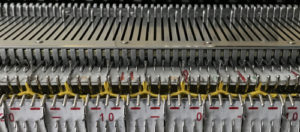 transfer all ribber stitches to top bed, knit 2 rows, bind off. None of my swatches were blocked other than by some tugging, particularly along the bottom edge. The spacing between stitches is narrower because ladders created by single needles left out of work are formed by yarn lengths that are shorter than those that happen when stitches are knit and then in turn dropped. The height of the swatch is also affected, and the half fisherman texture in the wool swatch, in particular, is more evident.
transfer all ribber stitches to top bed, knit 2 rows, bind off. None of my swatches were blocked other than by some tugging, particularly along the bottom edge. The spacing between stitches is narrower because ladders created by single needles left out of work are formed by yarn lengths that are shorter than those that happen when stitches are knit and then in turn dropped. The height of the swatch is also affected, and the half fisherman texture in the wool swatch, in particular, is more evident.
More variations to try in a multiple of 3+1: using either method or a DIY cast on, dropping (yellow) stitches marked with a * at the end, or transferring them to right or left and setting the main bed to tuck in one direction only. 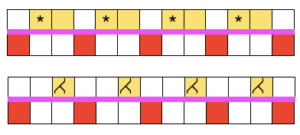 When the work is removed from the machine, stretch cast on outwards, then give each “scallop” a really good pull downwards. Steam lightly over the scallops to set them. Variations of the double bed trims may be worked on the single bed as well.
When the work is removed from the machine, stretch cast on outwards, then give each “scallop” a really good pull downwards. Steam lightly over the scallops to set them. Variations of the double bed trims may be worked on the single bed as well.
Ribber trims 2
This is an illustration of the #3 frill from the Ribber Techniques Book:
1. COR: knit a zigzag row to left, hang comb and weights, no circular rows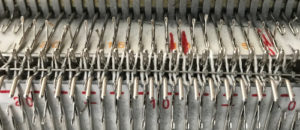 2. knit second zigzag row to right
2. knit second zigzag row to right 3. transfer stitches as shown
3. transfer stitches as shown  4. knit to left
4. knit to left  5. knit back to the right
5. knit back to the right 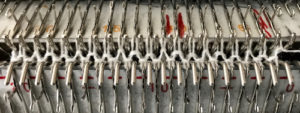 repeat steps 3-5 to the desired height
repeat steps 3-5 to the desired height
For another variation, knit 4 rows rather than 2 between transfers. My yarn is still a 2/24 acrylic. The trim would look quite different using a thicker yarn or even simply a tighter tension. I continued in rib. Ribber stitches could also be transferred to the top bed for continuation in stocking stitch 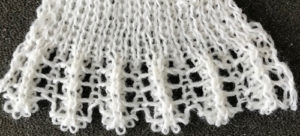
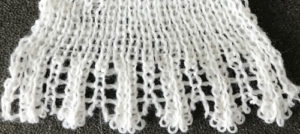 In theory, it is possible to knit lace transfers in Brother by dropping the ribber bed enough for the lace carriage to move across the beds while clearing the gate pegs. This remains on my “try someday” list. To my mind, hand transferring remains the best way to deal with lace/ ribber stitches combined.
In theory, it is possible to knit lace transfers in Brother by dropping the ribber bed enough for the lace carriage to move across the beds while clearing the gate pegs. This remains on my “try someday” list. To my mind, hand transferring remains the best way to deal with lace/ ribber stitches combined.
Tuck patterns on the main bed (or slip stitch) designs can be used to automate and create patterns where holding is recommended in some sources ie.  For a punchcard machine, the repeat must be a factor of 24 in width ie. 6 or 8, or 12 stitches wide. Electronic knitters can draw a single repeat, either the one on the left also using color reverse or the one on the right. Punchcard knitters need to punch the grey squares on the right across the card and repeat it in height. An extra all-knit row needs to be added at the top of each series of 4 rows tucked for the loops to be knit off automatically by the machine. Step 4 in the techniques book, resetting the main bed to N to knit a row after every 4 rows in a holding pattern is missing in their illustration above.
For a punchcard machine, the repeat must be a factor of 24 in width ie. 6 or 8, or 12 stitches wide. Electronic knitters can draw a single repeat, either the one on the left also using color reverse or the one on the right. Punchcard knitters need to punch the grey squares on the right across the card and repeat it in height. An extra all-knit row needs to be added at the top of each series of 4 rows tucked for the loops to be knit off automatically by the machine. Step 4 in the techniques book, resetting the main bed to N to knit a row after every 4 rows in a holding pattern is missing in their illustration above.  The punchcard repeat: punch each grey square to match the illustration
The punchcard repeat: punch each grey square to match the illustration  A few to try, shown in repeat X2, as BW gridded .bmps, and with the color reversed for knitting. All but one are 12 stitches in width, suitable for punchcard machines as well
A few to try, shown in repeat X2, as BW gridded .bmps, and with the color reversed for knitting. All but one are 12 stitches in width, suitable for punchcard machines as well  Too much black? want to count those black squares more easily? pick your preferred grid color, it will disappear when the image is saved
Too much black? want to count those black squares more easily? pick your preferred grid color, it will disappear when the image is saved 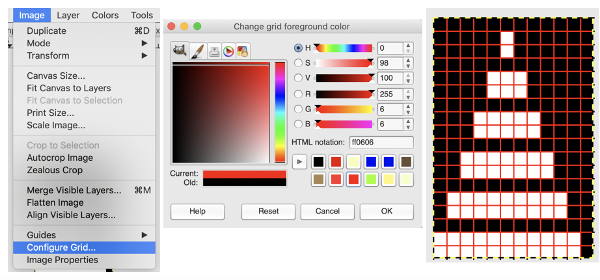 A screen grab from my iMac shows the original charts and the resulting single repeat .bmps after working in GIMP, ready for download with color reverse option and use on the electronic machines. Ayab knitters, in addition, would need to program the repeat in width to match the number of needles planned for use in the piece
A screen grab from my iMac shows the original charts and the resulting single repeat .bmps after working in GIMP, ready for download with color reverse option and use on the electronic machines. Ayab knitters, in addition, would need to program the repeat in width to match the number of needles planned for use in the piece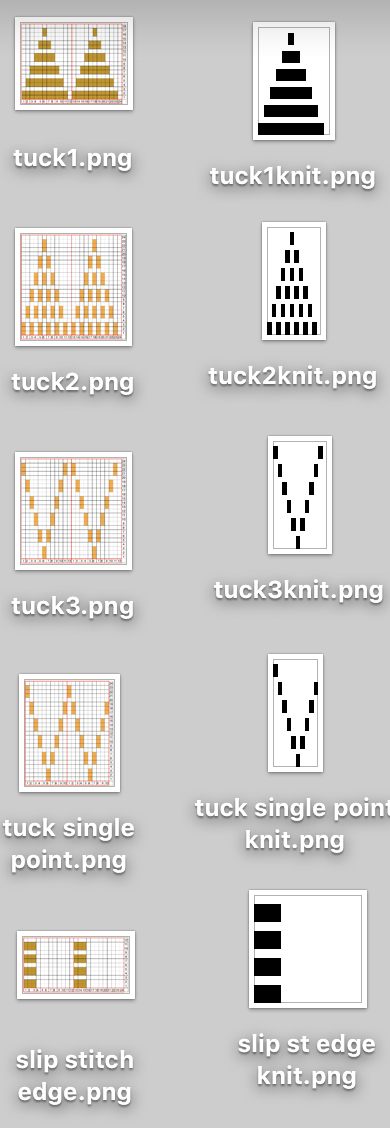
Ribber trims/edgings 1
An example of a common ruffle/ frill is produced with variations using both beds: cast on for every needle rib, knit X rows at full fisherman rib, followed by X rows at half-fisherman, and then possibly by plain rib for X rows, EON rib or even following with transfer to the single bed for X rows, bind off. The yarn used in this swatch is a wool-rayon blend 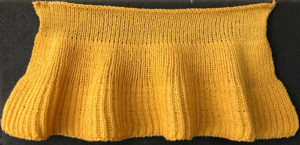 Needle transition arrangements to produce a ruffled edge:
Needle transition arrangements to produce a ruffled edge:
bring every needle into work, and cast on every needle rib.
Knit a minimum of 6 rows.
Transfer every other stitch from the ribber up to the main bed
adjust tensions on both beds, and continue in rib to the desired length. The yarn used in the swatch is a 2/8 wool on a Brother standard, which pushes the machine in every needle rib. The appearance of the ruffle will vary, as usual, depending on the yarn’s thickness, fiber content, and knitting tension adjustments on either or both beds.  Exaggerated frilled starts: no cast-on needed, working on every other needle patterning on both beds. A few rows will produce a curly edge, and more rows a ruffle proportionate in depth to the number of rows.
Exaggerated frilled starts: no cast-on needed, working on every other needle patterning on both beds. A few rows will produce a curly edge, and more rows a ruffle proportionate in depth to the number of rows.  Passap KM: AX/AX or AX/KX 4-10 rows, continue in plain rib N/N
Passap KM: AX/AX or AX/KX 4-10 rows, continue in plain rib N/N
AX/KX 4-10 rows, knit 1-row N/N, transfer to 1X1rib, continue to knit in plain rib
racking cast on
BX/KX 6-10 rows, continue in plain rib
Pushers in the upper work position (UWP) will make the needle knit while those in the lower nonworking position (NWP) will respond to lock patterning settings. E6000 either program the front bed for the pattern (1000) or bring every other pusher completely out of work to avoid having them return to work position after the first pass. The motif repeat for 8 stitches/rows usable on any machine
 Working it on Brother becomes a bit fiddly. Whether working on a punchcard or electronic KM, it is possible to introduce patterning on either or both beds as seen below. I preferred the look obtained with the racked cast on at the start. Setting up the Brother machine: program the repeat, half pitch for every needle rib, air knit to place the pattern on the bed so that the first needle on the left (or right if you prefer) is preselected forward and will produce a knit stitch on the first row knit. The yarn used is a 2/24 acrylic
Working it on Brother becomes a bit fiddly. Whether working on a punchcard or electronic KM, it is possible to introduce patterning on either or both beds as seen below. I preferred the look obtained with the racked cast on at the start. Setting up the Brother machine: program the repeat, half pitch for every needle rib, air knit to place the pattern on the bed so that the first needle on the left (or right if you prefer) is preselected forward and will produce a knit stitch on the first row knit. The yarn used is a 2/24 acrylic 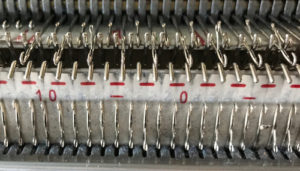 Both beds are set to knit, and lili buttons will be in use. On the ribber bed, the second needle from each side will knit, so starting on the left side of the ribber the first needle to the right of the first needle in work on the main bed is brought into work. It will need to be the second needle in work when the carriage moves from left to right in pattern knitting
Both beds are set to knit, and lili buttons will be in use. On the ribber bed, the second needle from each side will knit, so starting on the left side of the ribber the first needle to the right of the first needle in work on the main bed is brought into work. It will need to be the second needle in work when the carriage moves from left to right in pattern knitting  now another needle on the ribber is brought in to work on the far left, it will tuck with lili selection when moving from left to right
now another needle on the ribber is brought in to work on the far left, it will tuck with lili selection when moving from left to right 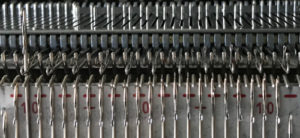 remember the ribber rule with lili buttons: an even number of needles must be in work, this shows the start and end of selection on the ribber on alternate needle tape markings, as required
remember the ribber rule with lili buttons: an even number of needles must be in work, this shows the start and end of selection on the ribber on alternate needle tape markings, as required  It is sufficient to continue with no circular rows after the first zigzag one. The start will be “loopy”, but will improve when the bottom row is stretched vigorously. In this Brother version, the first row of the pattern needs to be selected toward the carriage and yarn after the first pass by the paired carriages. Beginning COR, a row is knit to the left side. The knit carriage is removed from the bed and brought back to the right. COR: a “free pass” can be made with the machine set to tuck in both directions as well as to slip. Using tuck avoids errors in recalling to switch cam button functions. Using KCI (or II) the carriage with no yarn makes the free pass preselection row to the left, where the carriages are coupled again. I used KCI for my swatch. Before continuing to knit make certain lili buttons are engaged, that both carriages are set to tuck in both directions, and continue in pattern for X rows. Switch both carriages to N/N and continue in every needle rib (or knit 1-row N/N, transfer, and continue in EON rib or single bed). If stitches are transferred for EON rib or stocking stitch knit on a single bed, the yarn tension will need to be adjusted.
It is sufficient to continue with no circular rows after the first zigzag one. The start will be “loopy”, but will improve when the bottom row is stretched vigorously. In this Brother version, the first row of the pattern needs to be selected toward the carriage and yarn after the first pass by the paired carriages. Beginning COR, a row is knit to the left side. The knit carriage is removed from the bed and brought back to the right. COR: a “free pass” can be made with the machine set to tuck in both directions as well as to slip. Using tuck avoids errors in recalling to switch cam button functions. Using KCI (or II) the carriage with no yarn makes the free pass preselection row to the left, where the carriages are coupled again. I used KCI for my swatch. Before continuing to knit make certain lili buttons are engaged, that both carriages are set to tuck in both directions, and continue in pattern for X rows. Switch both carriages to N/N and continue in every needle rib (or knit 1-row N/N, transfer, and continue in EON rib or single bed). If stitches are transferred for EON rib or stocking stitch knit on a single bed, the yarn tension will need to be adjusted.
To review: lili buttons on ribber, checking needle selections on both beds. Cast on with no circular rows, zigzag only, option 1: tuck <– –>, tuck <– –> loops will build upon every other needle for single rows, so the frill can be continued for any desired height
option 2: tuck <– –>, tuck <– –> to desired # of rows, knit 1 row N/N, transfer for 1X1 rib
option 3: combination slip/tuck
With no circular rows after the zigzag note the edge, and the amount of stretch
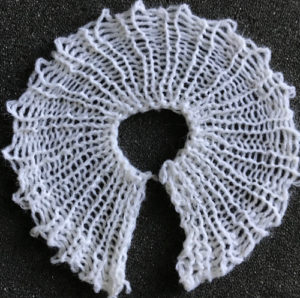 Using a racking cast on followed by the same carriage settings as above
Using a racking cast on followed by the same carriage settings as above
COR zigzag row right to left
COL rack 1 to left (increase 1 number on racking lever), KCI (pattern pre-select), program row 1 of pattern, knit one row to the right
COR rack to right (decreasing number) set both beds to tuck, and knit X rows (I chose 10). After completing the desired number of rows continue in every needle rib or knit one row with carriages set to N/N, transfer for every other needle rib, and continue on the EON rib. 
 Both pieces compared for width and rippling
Both pieces compared for width and rippling
I was plagued with random dropped stitches after my transfer to EON rib, one seen above left.
I finally sorted out that I had been using a ribber arm from an older model punchcard machine. When I replaced it with the later model arm shown at the top in the photo below, etched by the factory with #2 (outlined in magenta), I no longer had any problem.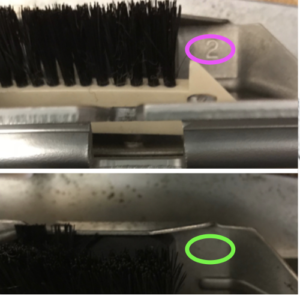
The latch opening plate use and installation
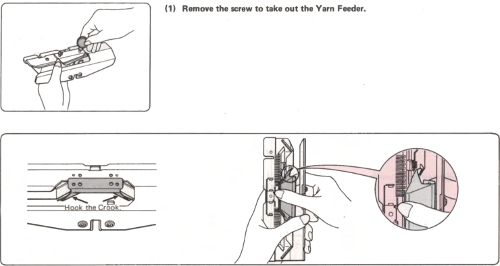

Here the latch opening plate has been secured into place in the connecting arm without the #2 mark. The change in height is noticeable, and brings the unit closer to the needles when on the machine during knitting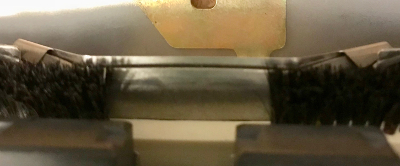
A reminder: if the needle presser bar on the ribber (all plastic) is to be removed, it is reinserted back in with ridges facing, and flat side down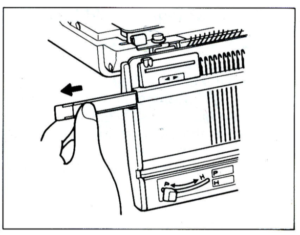
From the Brother Ribber Techniques book: frills and more:pp113-115

 An intro to scallops: p.120
An intro to scallops: p.120

A previous post on checking ribber alignment
Casting on, double bed
The very early machine manuals had illustrations not often shared in later ones. This is on combs whose wires had looped ends  This cast-on comb is favored by many, but not by me. I find it heavy to start with on small pieces, and if long pieces of knitting are rolled up as some do rather than moving the comb up as shown here, the proportional weight changes as the knitting lengthens, which can affect the gauge.
This cast-on comb is favored by many, but not by me. I find it heavy to start with on small pieces, and if long pieces of knitting are rolled up as some do rather than moving the comb up as shown here, the proportional weight changes as the knitting lengthens, which can affect the gauge. 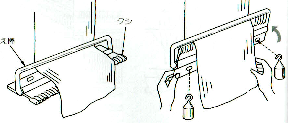
 The Brother KR850 manual, pp 19-29 has clearly illustrated how-tos for this process. Old manuals often have a translation from other languages that may be found to be from amusing to confusing or even incomprehensible. Method 2 below illustrates the “broken toe” cast on. The term partial knitting has nothing to do with its more familiar application to holding techniques.
The Brother KR850 manual, pp 19-29 has clearly illustrated how-tos for this process. Old manuals often have a translation from other languages that may be found to be from amusing to confusing or even incomprehensible. Method 2 below illustrates the “broken toe” cast on. The term partial knitting has nothing to do with its more familiar application to holding techniques.

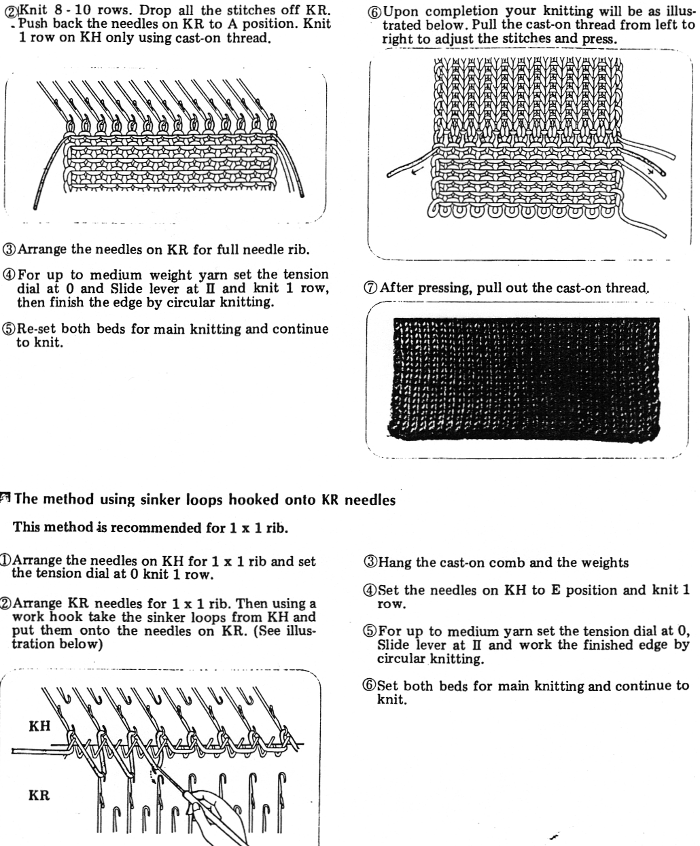 The tubular cast-on is probably the most commonly used and published one. It tends to have an uneven edge, but steps can be taken to compensate for this. In every case, on the first row, the yarn travels from a needle on one bed to a needle on the other. Remove the single bed sinker plate. Push the ribber up to the work position, and connect both carriages with the connecting arm. Make a couple of passes with the coupled carriages to ensure the needles are aligned properly. To drop the yarn between the beds prior to threading it into the carriage threading it through a double-eyed bodkin will make it easier for it to be dropped between the beds. It is commonly advised that the cast on the zigzag row be done on the tightest tension possible. That also varies depending on the yarn, whether the cast-on is to be decorative, or if the loops that are commonly considered undesirable are in turn to be chained through to match a latch tool bind off at the top of the piece. It is often recommended that for the circular cast- ons 3 circular rows be used. That produces one side of the rib with small “floats” with an appearance that differs from the reverse side. Arrows in this illustration point to that third row.
The tubular cast-on is probably the most commonly used and published one. It tends to have an uneven edge, but steps can be taken to compensate for this. In every case, on the first row, the yarn travels from a needle on one bed to a needle on the other. Remove the single bed sinker plate. Push the ribber up to the work position, and connect both carriages with the connecting arm. Make a couple of passes with the coupled carriages to ensure the needles are aligned properly. To drop the yarn between the beds prior to threading it into the carriage threading it through a double-eyed bodkin will make it easier for it to be dropped between the beds. It is commonly advised that the cast on the zigzag row be done on the tightest tension possible. That also varies depending on the yarn, whether the cast-on is to be decorative, or if the loops that are commonly considered undesirable are in turn to be chained through to match a latch tool bind off at the top of the piece. It is often recommended that for the circular cast- ons 3 circular rows be used. That produces one side of the rib with small “floats” with an appearance that differs from the reverse side. Arrows in this illustration point to that third row.  Only two circular rows do the job and avert that problem. Conversely, 4 tubular rows may give extra firmness and strength when using very thin yarns. For the final row set both carriages to close the zigzag, increase the stitch size to rib setting, and knit one row. At that point, stitches can be rearranged on the needles if needed.
Only two circular rows do the job and avert that problem. Conversely, 4 tubular rows may give extra firmness and strength when using very thin yarns. For the final row set both carriages to close the zigzag, increase the stitch size to rib setting, and knit one row. At that point, stitches can be rearranged on the needles if needed.
For a tighter cast-on row sometimes a thin elastic is threaded with the main yarn and used for only the first zigzag row. Do not hang ribber weights until the cast-on is completed.
Other variations: set up knitting on a single bed only with waste yarn and ravel cord and cast on comb and weights, ending with a row of ravel cord. Using both beds, begin with garment yarn, and follow instructions for tubular cast-on. When knitting is complete tug waste yarn lengthwise to set stitches before removing the ravel cord.
On the double bed, after the zigzag row, lay a piece of ravel cord right on top of the zigzags, dropping the ends between the beds and anchoring the ends with a clothespin or other small clip. It will be enclosed in the knit as you continue to work. Upon completion of the piece, pull lengthwise on both ends of the cord to set stitches before removing it.
Cast on using an e-wrap single bed: knit several rows in waste yarn, either in EON rib or single bed. If single-bed knitting is used, poke the ribber cast-on comb through the waste knit or use it to cast on a single bed, making it the future home for weights. If a rib start is used, the stitches then would need to be transferred to the main bed. A row is then knit with a ravel cord. Proceed with a single bed e-wrap cast on, dropping the ribber if needed. When the e-wrap is completed, bring the ribber bed back up if it had been lowered. Knit a row to the opposite side. Transfer stitches to your desired arrangement. Thread the yarn, and proceed in rib.
Since my trial swatch was quite narrow, I opted to skip the waste yarn or rib cast-on and transfer to the top bed prior to e-wrapping; the yarn used is a 2/8 wool 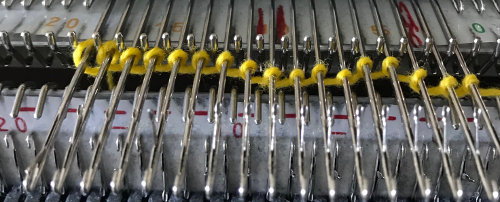 before the next pass, make certain there are no needles in work on the ribber, they will pick unwanted loops, also, give a tug at the yarn on the carriage side as you begin to knit the next row in order to avoid loops as seen on the right below. Knit to the opposite side.
before the next pass, make certain there are no needles in work on the ribber, they will pick unwanted loops, also, give a tug at the yarn on the carriage side as you begin to knit the next row in order to avoid loops as seen on the right below. Knit to the opposite side.  Transfer stitches in the desired needle setup. With waste yarn, ravel cord, and weights prior to its start this cast-on may be used for wider flat ribs ie 2X2, 3X3, etc. Here the comb is in place, ready for 1X1 rib
Transfer stitches in the desired needle setup. With waste yarn, ravel cord, and weights prior to its start this cast-on may be used for wider flat ribs ie 2X2, 3X3, etc. Here the comb is in place, ready for 1X1 rib 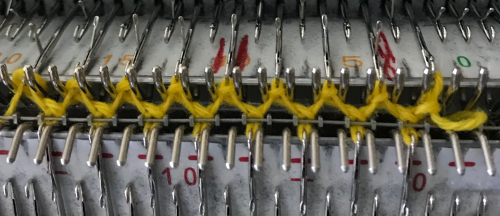 the results
the results 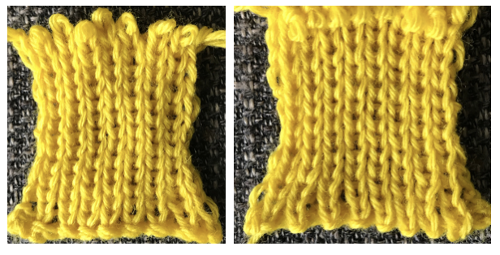 It is also possible to e-wrap on empty needles set up for rib on both beds. The first pair of diagrams show movement from the left toward the right. Loops are wound in alternating clockwise or counterclockwise directions as seen below, being careful not to make the loops too tight.
It is also possible to e-wrap on empty needles set up for rib on both beds. The first pair of diagrams show movement from the left toward the right. Loops are wound in alternating clockwise or counterclockwise directions as seen below, being careful not to make the loops too tight. 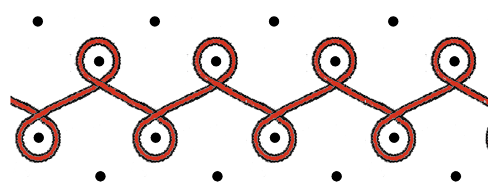
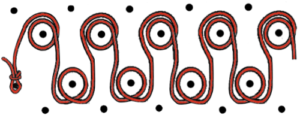 working from the right to the left side
working from the right to the left side  The e-wraps may be made with variations of movements that are counterclockwise or clockwise. Depending on the variations there can then be two distinct sides, requiring a choice to be made as to whether the purl or knit sides of the final fabric will be facing out. With a clockwise wrap a row of purl loops (red arrow in swatches)) will show at the bottom of the “wrong”, purl side. To reverse them, wrap all stitches counterclockwise.
The e-wraps may be made with variations of movements that are counterclockwise or clockwise. Depending on the variations there can then be two distinct sides, requiring a choice to be made as to whether the purl or knit sides of the final fabric will be facing out. With a clockwise wrap a row of purl loops (red arrow in swatches)) will show at the bottom of the “wrong”, purl side. To reverse them, wrap all stitches counterclockwise.
Here all needles are wrapped clockwise, a slip knot on the first needle on left would steady the yarn, needles are brought to hold-position on both beds for easier knitting on the next row,  which is knit carefully to the opposite side
which is knit carefully to the opposite side
 the comb is then hung. Make certain its teeth are placed properly across the row holding stitches down. Here they are not on the right, resulting in the issue marked with black arrows at the bottom of the corresponding swatch
the comb is then hung. Make certain its teeth are placed properly across the row holding stitches down. Here they are not on the right, resulting in the issue marked with black arrows at the bottom of the corresponding swatch  tension adjustments may be required. Knit slowly and check that the stitches are properly knitting off. Bringing needles to hold on both beds for a few rows prior to knitting them may help prevent random dropped stitches.
tension adjustments may be required. Knit slowly and check that the stitches are properly knitting off. Bringing needles to hold on both beds for a few rows prior to knitting them may help prevent random dropped stitches.
This is the setup with alternating clockwise and counterclockwise wraps on both needle beds. This cast-on has a good deal of stretch and looks the same on both sides, its test swatch is shown on the right.

 If working in fine yarns, 2 tubular rows may be needed after the wrapped cast-on.
If working in fine yarns, 2 tubular rows may be needed after the wrapped cast-on.
Another handout from eons ago follows below. The broken toe cast-on is often used whenever both the knit carriage and the ribber are used to create the fabric but stitches are dropped off one bed or the other, such as in drop stitch lace. The placement for the comb if the ribber stitches are to be dropped is illustrated below. Red and yellow show the areas held down by the comb’s wire that will remain on the main bed when the ribber stitches are dropped. Below it, the wrong placement of the comb for this purpose is shown. The reverse would be true if the main bed stitches were going to be the ones to be dropped. 
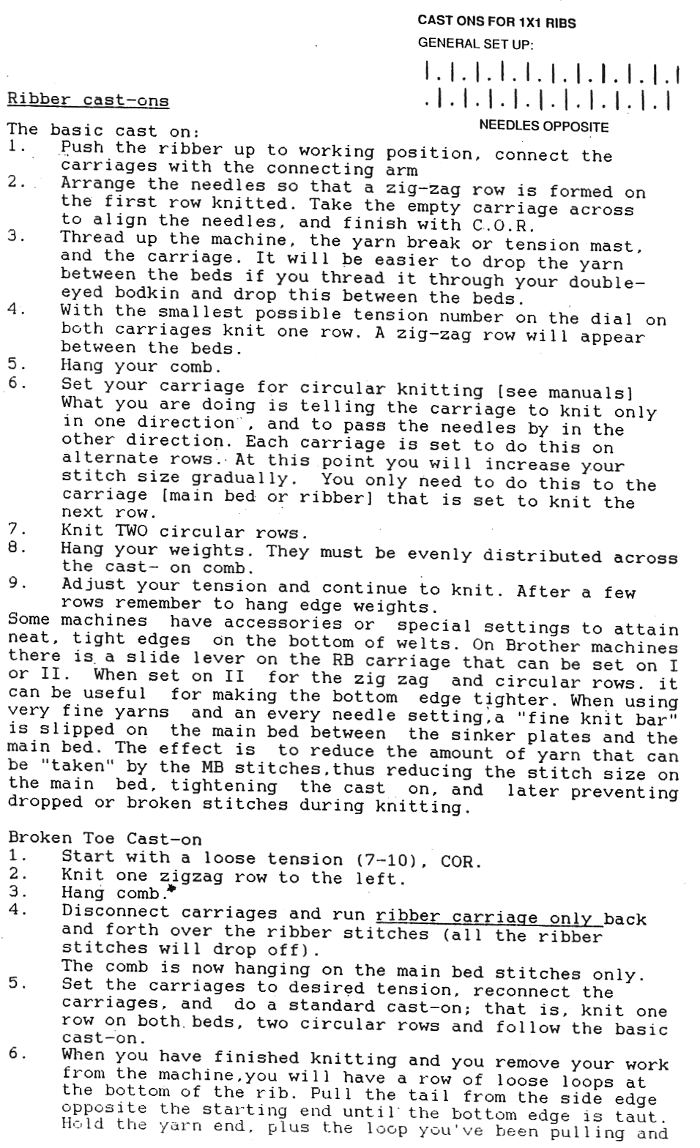
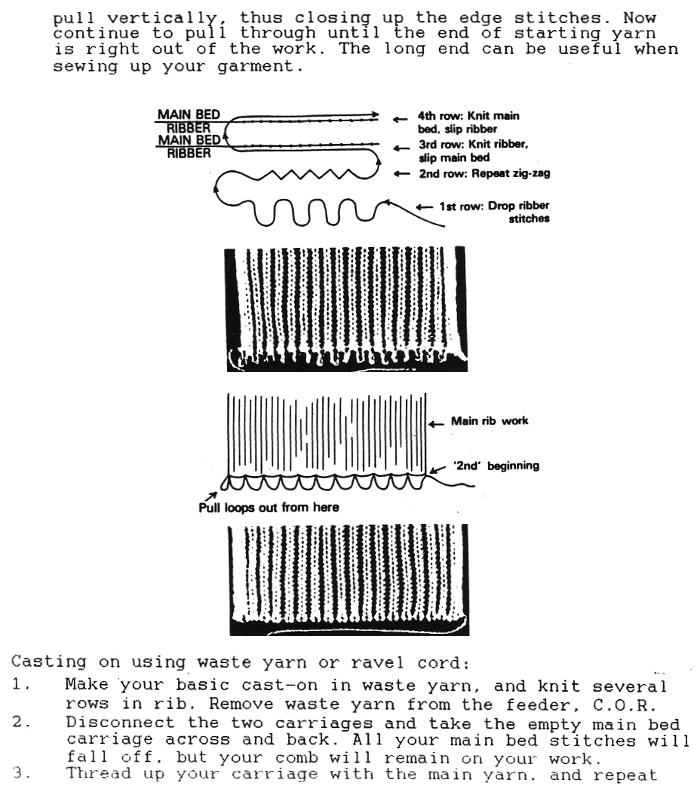
 These illustrations for the comb setups in other rib configurations were published in a Toyota ribber manual
These illustrations for the comb setups in other rib configurations were published in a Toyota ribber manual  From the Brother KR850 manual Casting-on for 2X2 rib
From the Brother KR850 manual Casting-on for 2X2 rib 


 For more configurations see the 2022 post: More on standard and modified 1X1 and 2X2 ribs
For more configurations see the 2022 post: More on standard and modified 1X1 and 2X2 ribs
Casting on the double bed info shared in previous blog posts
Racked ribber cast on and tips included racked cast for every needle rib, and samples knit on Passap, for 2X1 and 2X2 commercial ribs
Picot cast on for every needle rib
Transitions from EON (every other needle) to FNR (full needle rib)
Taking advantage of the “wavy” first row to produce a ruffled effect: zigzag row at rib tension or one number less than rib. Set one carriage to tuck, and the other to knit. Make one pass with both carriages to the opposite side. Reverse carriage settings, and make a second pass to the opposite side. Repeat one more pair of rows, reversing carriage settings with each pass (as in the fisherman rib setting). One may also experiment with more tucking variations or a greater number of rows in a pattern before proceeding in the rib. Before the closing row, depending on the configuration chosen, slipping on one bed and knitting on the other may make for a more pleasing transition.
The start of playing with needle/pusher arrangements, with both beds knitting in pattern. Instructions will follow in a future post on ribbed trims.  Decorative cast-ons and beginnings
Decorative cast-ons and beginnings
Ribber trims 2
Ribber trims/edgings 1
Online resources:
Ribber e wrap cast on video by Roberta Rose Kelly
A decorative cast-on with lots of hand transfers on the ribber bed by Emanuela Mammarella.
Studio tips and techniques #13
Binding off, double bed
A DBJ discussion re Ayab use recently brought up the topic of ribber bind-offs. My plan for this post is to gather information and illustration on a variety of methods, beginning with those illustrated by Brother, then moving on to others I have come across over the years in a variety of publications. Transfer to single bed methods: transfer all the stitches onto the top bed, then use single bed techniques to cast off. Having multiple stitches unevenly distributed can make the cast-off lumpy, and such techniques may also be too tight for the fabric. For latched-through bind-offs, one way to get extra length/size in stitches on the main bed is to bring every other needle on the ribber back into work after transfers. Set the ribber to half-pitch, knit one row with both carriages set to knit to the other side, drop off newly created ribber stitches by using the ribber carriage only to release the stitches by moving it back to the opposite side, dropping the loops just created, adjust the amount of weight, and bind off. That extra knit row may also be useful in rib configurations that leave empty needles after the transfers. Loops will fill in empty needles. Chain only through stitches, not loops. The latter will help create enough give to bridge the gaps. Technically, once the ribber stitches are moved to the top bed, any single bed bind-off may be used, whether through single or double loops. Some techniques produce more pleasing results than others. Each look is different, as is the amount of stretch. Testing on swatches in specific yarns used helps one determine the preferred method. If a latch tool is used to do a crocheted bind-off after transferring a 1X1 rib it is possible to maintain the rib. Insert the tool from the front of the stitches that were originally on the back bed, and into the front of the stitches that were on the front bed. Stitches have “legs”, inserting the latch tool back to front from behind the right leg will change the direction of the lean in the chain. As one enters the center of the stitch, the left leg is picked up by default. 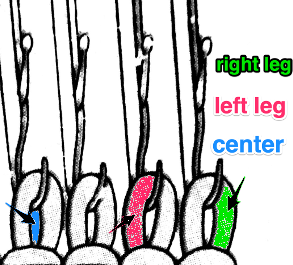 When latching stitches on the single bed after transferring all stitches to it, to keep bind off in the rib, on the purl stitches hook the stitch back to front (red line), on the knit stitches hook the stitch through the center (green line)
When latching stitches on the single bed after transferring all stitches to it, to keep bind off in the rib, on the purl stitches hook the stitch back to front (red line), on the knit stitches hook the stitch through the center (green line)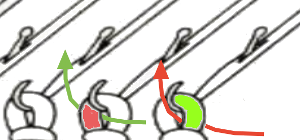 Reviewing approaches to binding off with needle and yarn: working single bed is sometimes performed on the machine and is illustrated below working from left to right. It is referred to as back or stem stitch and “sew off” method, and is shared in many of the old machine knitting manuals. It is easier to achieve if after knitting the last row one knits at least 2 or 3 more rows in waste yarn to make the stitches more accessible. The knit side shows single loops in view upon completion. Dropping small groups of stitches off as one makes progress across the row may make the technique easier, helping with the placement of the other hand to hold the work. On the machine, the fixed distances between needles and gate pegs help to keep the tension even. The backstitching may be done off the machine, but maintaining even tension there may be a bit harder.
Reviewing approaches to binding off with needle and yarn: working single bed is sometimes performed on the machine and is illustrated below working from left to right. It is referred to as back or stem stitch and “sew off” method, and is shared in many of the old machine knitting manuals. It is easier to achieve if after knitting the last row one knits at least 2 or 3 more rows in waste yarn to make the stitches more accessible. The knit side shows single loops in view upon completion. Dropping small groups of stitches off as one makes progress across the row may make the technique easier, helping with the placement of the other hand to hold the work. On the machine, the fixed distances between needles and gate pegs help to keep the tension even. The backstitching may be done off the machine, but maintaining even tension there may be a bit harder.
Some references advocate this method for binding off the rib after transferring all stitches to the main bed. A row is knit across the transferred stitches prior to stitching through the now single thickness.
The process, whether executed on the machine or off, to my mind is easier with waste yarn knit after the transfers. Here is an illustration of single bed knitting removed from the machine.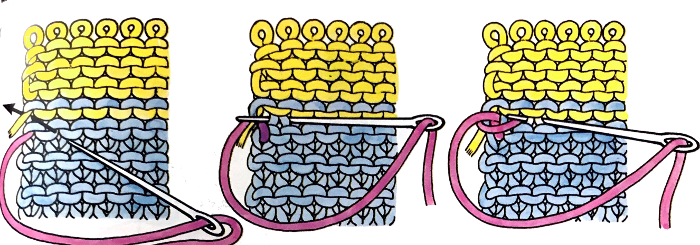
The top of the last row of the body of the knit may then be bound off using a crochet hook or latch tool chain stitch using a continuous thread,  or the needle and yarn sewing method may be used. There is a limit as to the length of yarn used so as not to pose problems. Very wide pieces may prove to be a challenge, requiring more than a single yarn end to complete the bind-off. My own yarn end max limit for sewing up or off is about 18 inches
or the needle and yarn sewing method may be used. There is a limit as to the length of yarn used so as not to pose problems. Very wide pieces may prove to be a challenge, requiring more than a single yarn end to complete the bind-off. My own yarn end max limit for sewing up or off is about 18 inches
For folks who prefer to view videos, these are some methods on single-bed bind-offs offered by others on this topic:
latching off through looser stitches any KM, by Diana Sullivan my least favorite,
wrapping around needles, familiar to Passap owners, by Susan Guagliumi
several sinker plate bind-offs also by Susan Guabliumi. The very last method illustrated is my favorite go-to, around gatepegs whether single, double, or more, though I do it a different way.
Latch tool bind-offs without transferring both beds: 1. chaining through stitches on both beds
Knit the last row at a looser tension, and begin by setting it as high as possible in your first experiments. Knit a row to the left.
Lower the ribber slightly  Begin on the side opposite the carriage and the yarn end, moving in a zig-zag fashion.
Begin on the side opposite the carriage and the yarn end, moving in a zig-zag fashion.
Go through the center, front to back through the stitch on one bed, moving it behind the latch, then go through the center of the stitch on the opposite bed, hold its yarn in the hook of the needle, and pull it through the previous stitch held behind the latch.
Continue latching until ass the stitches have been picked up and bound off. Break the yarn and pull through the last stitch to secure it.  adapted from Passap publications
adapted from Passap publications 
Video: chain through each stitch on the machine by ArtOfClay.
2. transfer the stitches to the knit bed in Japanese machines, either bed on Passap, and after a plain knit row if textured patterns are in use.
Follow it with a last row of knitting, leaving all the needles on the ribber in work after the transfer.
Moving toward the carriage, using a latch tool, go through the center front to the back of the first stitch on one bed, moving it behind the latch. Then go through the center of the stitch on the opposite bed, holding its yarn in the hook of the needle, and pull it through the previous stitch held behind the latch. Continue across the bed, securing the last stitch.
In bind-offs such as these, the proper loops need to be latched through, or one may wind up with open stitches and no bind-off.
This Passap bind-off variation adapted for Brother machines is described in the post on fantasy fair isle patterning 
 3. Video after transferring to one bed, and taking off on waste yarn by BarbaraDeike
3. Video after transferring to one bed, and taking off on waste yarn by BarbaraDeike This edited illustration, also from a Brother manual, expands on the one above, showing how the yarn is threaded through the stitches in numbered sequence according to the stitch configuration for the ribbed fabric
This edited illustration, also from a Brother manual, expands on the one above, showing how the yarn is threaded through the stitches in numbered sequence according to the stitch configuration for the ribbed fabric
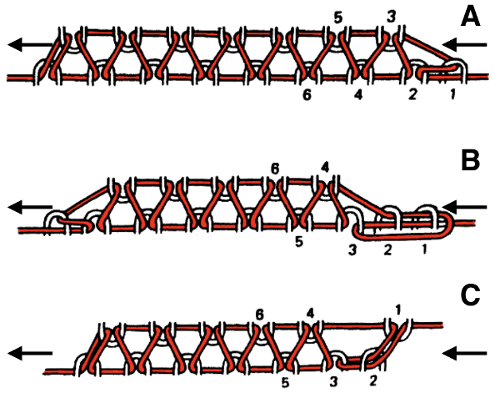 Using waste yarn on both beds:
Using waste yarn on both beds:  I prefer an alternative method for waste yarn scrap off, ending in place of circular or U knitting: knit the last row in garment yarn. Thread up waste yarn, and knit it at single-bed tension. Knit 4 rows on one bed, with a separate strand or even a second contrasting color of equal weight, and knit 4 rows on the opposite bed. Repeat alternating until there are more than 12 rows on each bed and scrap off. This will allow you to press the waste knitting only, and the flaps are opened up to reveal the tops of the stitches created on each bed. Finishing can then be executed as below.
I prefer an alternative method for waste yarn scrap off, ending in place of circular or U knitting: knit the last row in garment yarn. Thread up waste yarn, and knit it at single-bed tension. Knit 4 rows on one bed, with a separate strand or even a second contrasting color of equal weight, and knit 4 rows on the opposite bed. Repeat alternating until there are more than 12 rows on each bed and scrap off. This will allow you to press the waste knitting only, and the flaps are opened up to reveal the tops of the stitches created on each bed. Finishing can then be executed as below.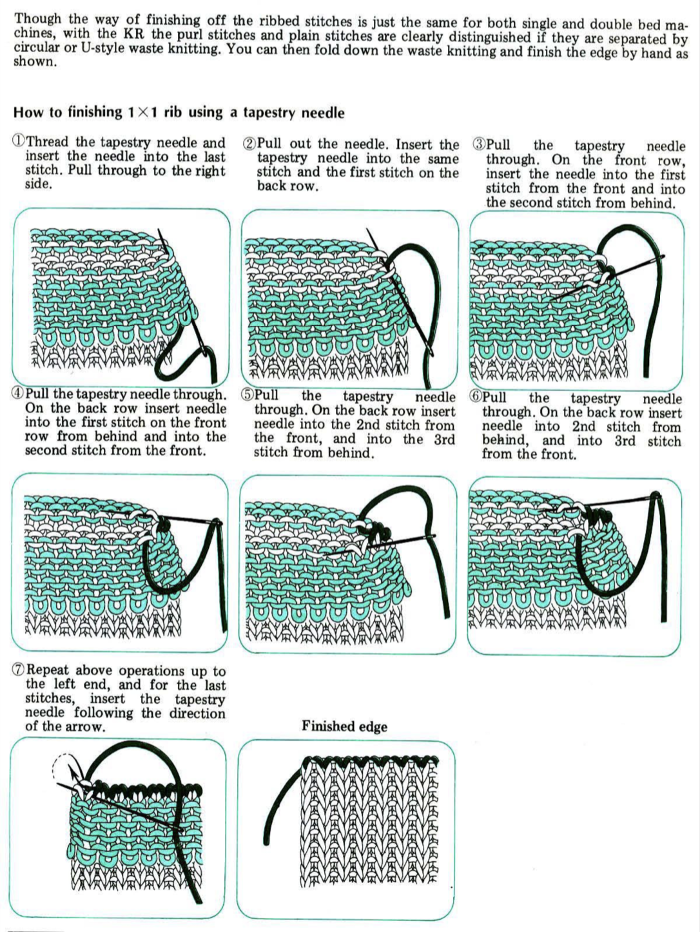
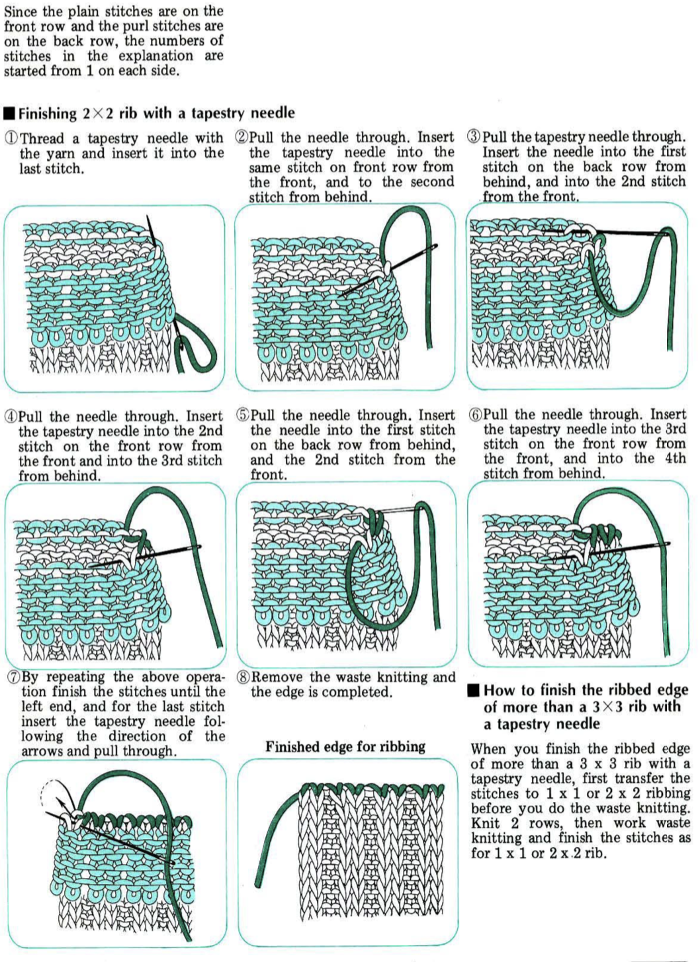
Slip stitch marking row 1X1 rib: EON needle is transferred to the top bed. From right to left: COR stitches that appear as knit ones on the purl ground are brought out to hold, the knit carriage is set to slip from left to right, and purl stitches will slip. Set the carriage to knit both ways, continue with waste knitting, drop the piece off the machine, and continue as illustrated in the circular fold-over method.
Here any waste yarn is folded over, exposing the tops of ribbed stitches. The threading and stitching sequence is numbered, illustrated for both one by one and two by two ribs. Depending on the planned seaming choice, an extra stitch may be added on either or both sides of the knit so that half a stitch or a whole one can be absorbed into the seam, resulting in a continuous rib configuration on the outside of the garment 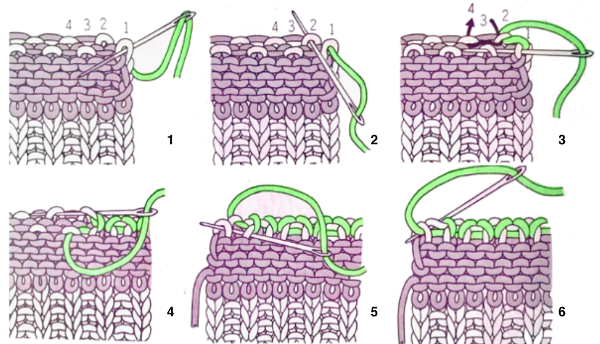 2X2 rib
2X2 rib

For added information and settings, see later post: More on standard and modified 1X1 and 2X2 ribs
